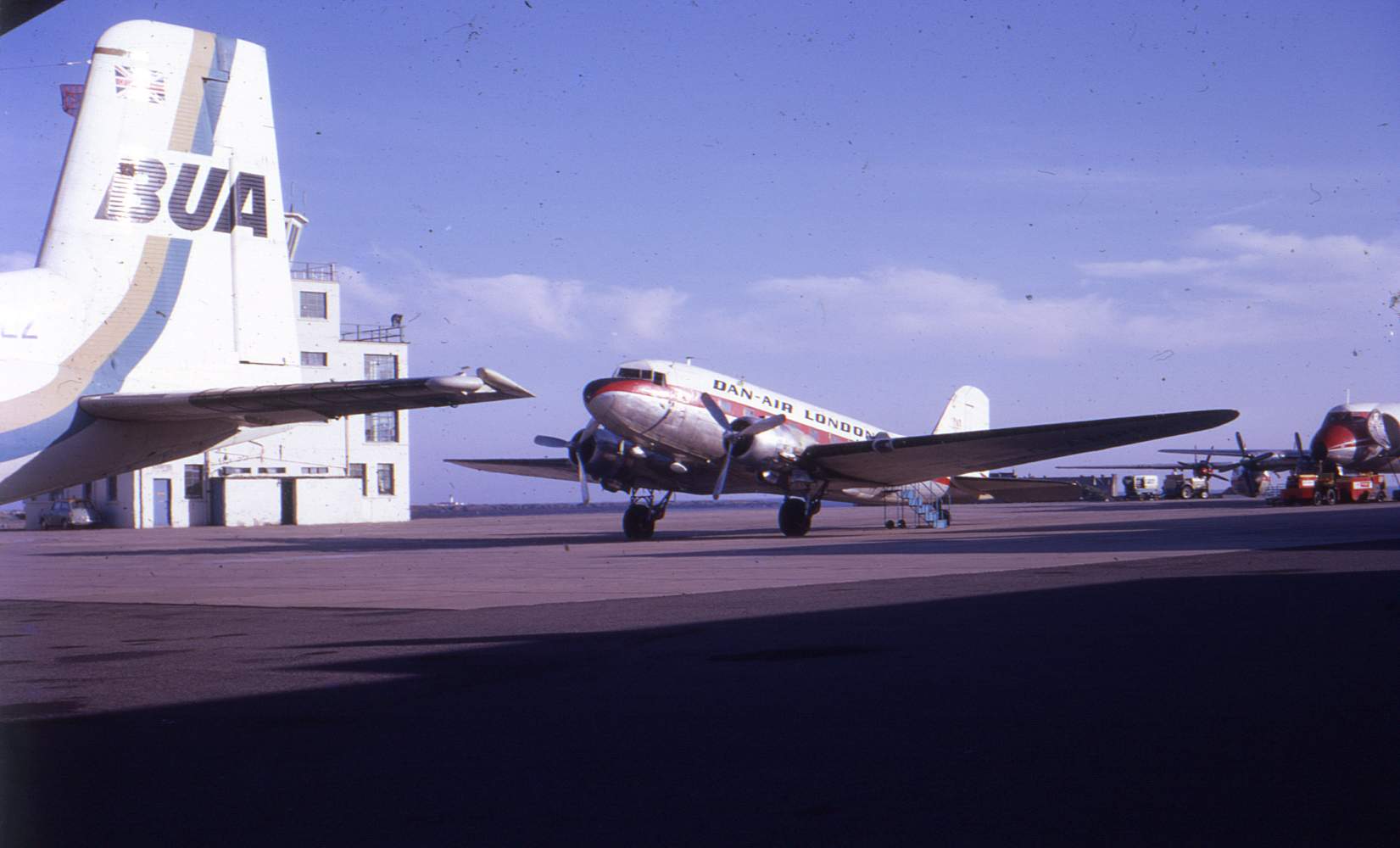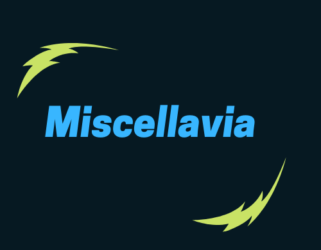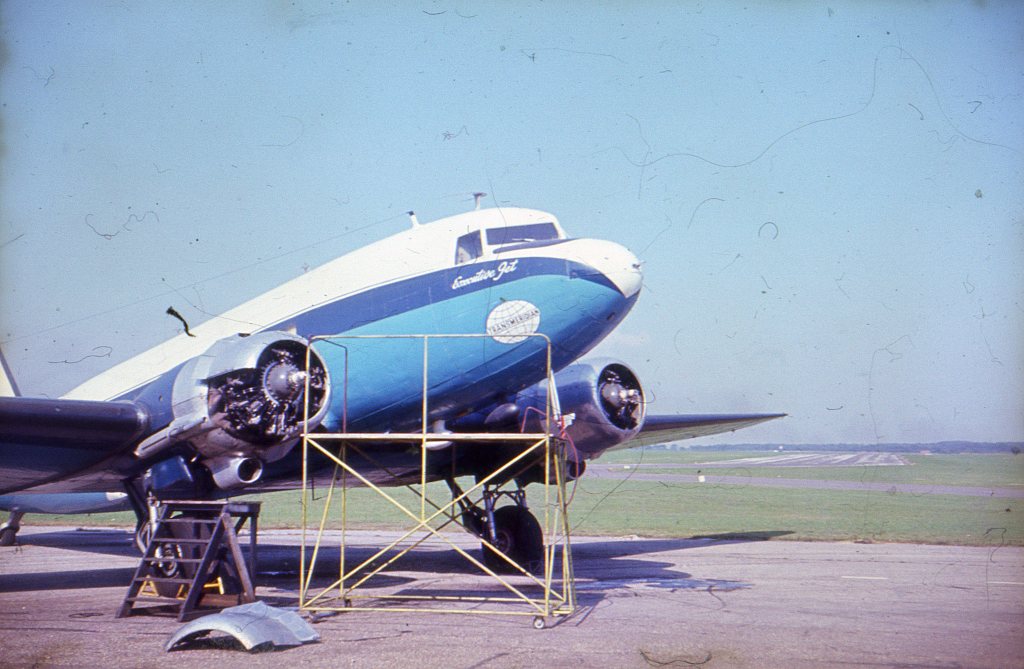
This particular DC-3 means a lot to me; it frequently used to overfly my Essex country home and was one of the more interesting sights Stansted could offer in the sixties and early seventies. When she moved on from STC to Transmeridian, Mike Keegan and his staff were often kind enough to let me visit G-AJRY and look around inside when she was parked at Stansted. I spent a pleasant morning at the home of STC’s Chief Pilot and learned some of the interesting tales surrounding the Dakota’s days with the company. A couple of decades later, I was working in Southern Africa and was fortunate to see her in a new guise, with a new claim to fame and new name – Delaney. The full story of this Dakota spans war-time Europe, continued military service in Canada, flights to Cuba during the early days of Fidel Castro, a long spell as a corporate transport with STC in England and, for close to the last fifty years, operations in Southern Africa.
WAR SERVICE:
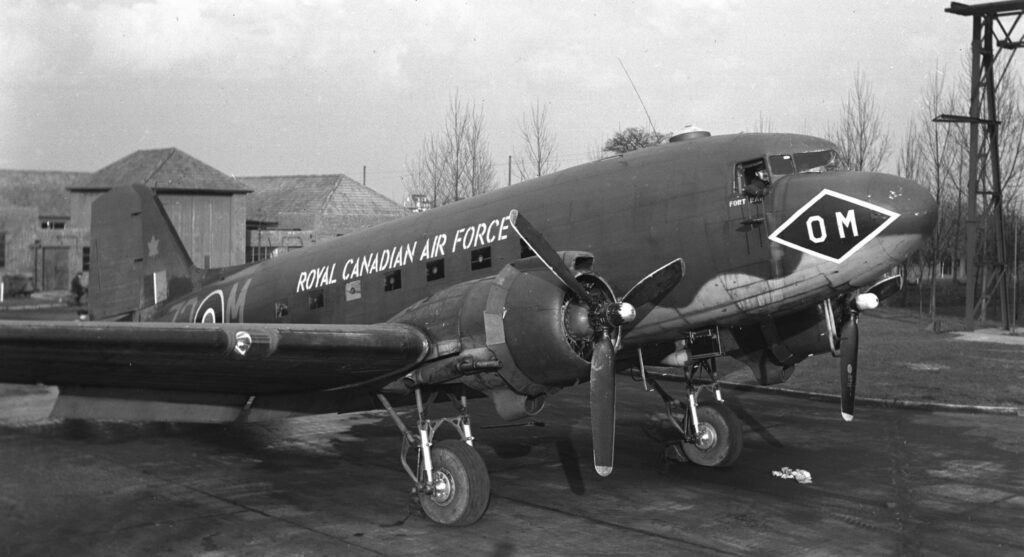
Construction Number 13331 was built at Oklahoma City as part of contract AC-28405 and delivered to the USAAF as 42-93421 on May 17th 1944. By May 23rd she had transferred north to Dorval, Montreal, as part of the UK/ USA’s Lend/ Lease scheme. With the newly-allocated RAF serial KG600 she made the transatlantic crossing, landing in Britain on 29th May 1944. KG600 seems to have spent some weeks with #1 Ferry Unit at Pershore following her arrival in the UK, possibly as a transport to move ferry pilots around in-between deliveries (1). The RAF’s 46 Group Dakota Modification Unit at Doncaster upgraded 600 to operational standard and she was transferred to 105 Operational Training Unit at Bramcote on 18th September 1944 (2). KG600 was then transferred to the nascent Canadian unit 437 Squadron which was, at that time, cutting its teeth as part of the Arnhem landings. 437 was the first all-Canadian transport squadron in Britain and, as part of 46 group, had been allocated thirteen experienced Canadian crews already flying with the Group (3). The Commanding Officer of 437, Acting Wing Commander John Sproule, arrived at Blakehill Farm, home to 233 Squadron RAF, on 4th September and the first nine crews arrived on September 15th a mere two days before the Arnhem operation.
(1) The main historical framework is from Air Britain’s ‘The DC-3 and its Predecessors’ by JMG Gradidge and the updates written by Jennifer Gradidge.
(2) Ref: Air Britain BCAN 1964. Note that 105 OTU mostly used Wellingtons until fully re-equipping with Dakotas in Spring 1945. However, KG600, KG568 and KG577 are reported by Air Britain as having been delivered to 105 before reallocation to 437 Squadron. Similarly, KG580 and 599 are recorded as going to 105 OTU prior to moving on to 48 Squadron. Their stay at Bramcote was of short duration, perhaps to train their crews prior to being sent to operational squadrons.
(3) Under the British Commonwealth Air training Plan of December 1939 (Article 15), graduates of Commonwealth air training would be able to join units and formations which identified with their respective Dominions. Initially, squadrons from different countries might well have the same squadron number which proved confusing. Subsequently, each Dominion was allocated a batch of squadron identities: Canada received #400 to 449 and 437 was the last to be formed from scratch. It was, however, the first Canadian Transport squadron to be formed in Britain as 435 and 436 had both been inaugurated in India.
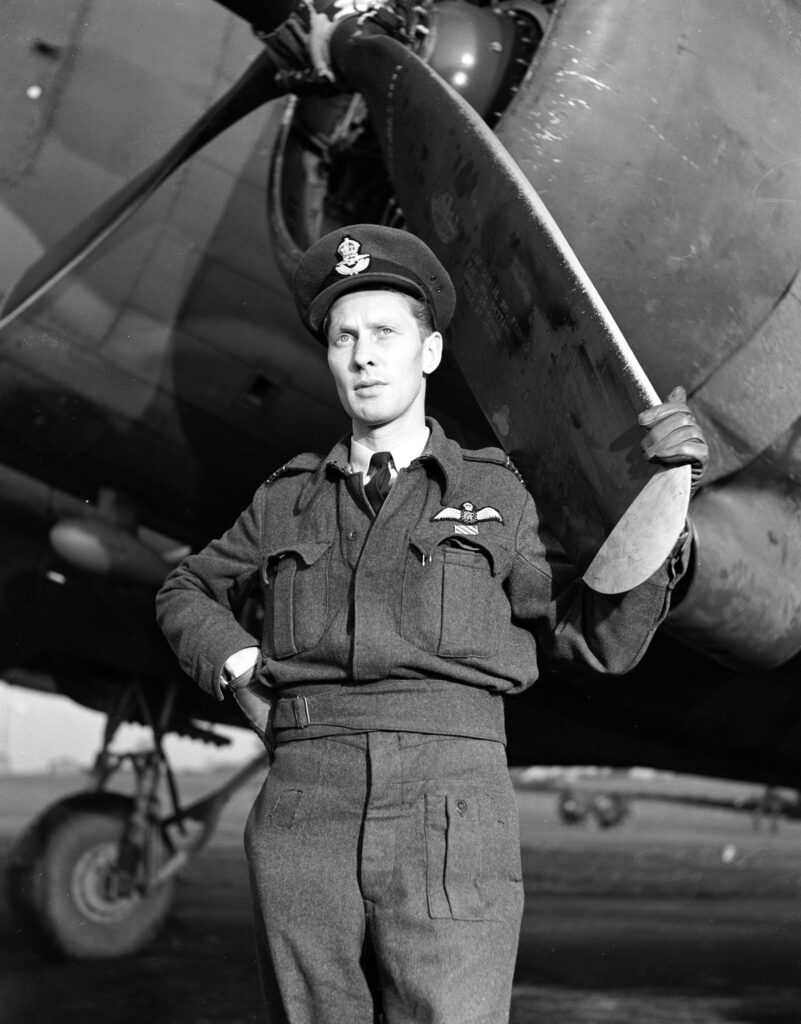
437 Squadron at Arnhem.
Fifteen crews were available for the first Arnhem lift and twelve departed Blakehill Farm towing Airspeed Horsa gliders on Sunday September 17th. They were led by Wing Commander Sproule and carried members of the British First Airborne division (1st Batallion, Kings Own Scottish Borderers) en route to Landing Zone ‘S’ to the north of the Arnhem railway line. Two of the crews allocated to 437 actually took part in the first Arnhem flight from Down Ampney rather than Blakehill Farm and were recorded as being on detachment from the Husky Squadron. It was a sunny autumn Sunday and the Squadron followed the established route via waypoints at Hatfield, Aldeburgh, Schouwen Island and Hertogenbosch with no aerial opposition. The glider-release occurred as planned and the Squadron returned home, its first mission completed. The following day, six 437 Squadron Dakotas towed Horsa gliders via the same route to Arnhem. They were carrying troops, jeeps and ancillary equipment. The repetition of both route and timetable was anticipated by the Germans and there was more flak than during the first operation. During the next two days, 437 flew transport missions to Brussels with mail, fuel and navigation equipment carried outwards and casualties on return to Down Ampney. The Squadron suffered its first loss when KG589 lost power to both engines and crash-landed. The crew survived and managed to dismantle the secret Gee and Rebecca navigational aids and carry them to Brussels.
437 Squadron continued to gather equipment and aircraft at Blakehill Farm and added ‘B’ and ‘C’ flights to the initial ‘A’ flight. They relied heavily upon other squadrons, such as their Blakehill co-tenants 233 Squadron, for maintenance facilities and even for the loan of aircraft. For example, Flying Officer Errol Q.Semple had transferred from 233 Squadron to 437 Squadron RCAF and, on the first Arnhem lift, he flew 233 Dakota KG441, an aircraft which he had regularly flown when on 233’s crew roster.
Both of the Blakehill squadrons suffered their worst losses of the Arnhem campaign on the re-supply mission of September 21st (see 233 Squadron thread) when enemy fighters made their impact felt for the first time. Ten 437 Squadron aircraft took part in the operation intended to deliver ammunition panniers to the beleaguered British paratroopers. When Luftwaffe FW190s attached, Errol Semple, flying KG410, was able to take to local cloud cover but four other Dakotas were less fortunate. KG387, KG376 and FZ656 were shot down and KG389 escaped to Brussels Evere where she crash-landed with flak damage to both engines. Twelve aircrew were killed, two captured and nine despatchers also lost their lives on September 21st.
Allied fighter cover was improved for the mission of September 23rd. 437 provided fifteen aircraft (plus FZ692 which failed to take-off) and fourteen successfully dropped their re-supply panniers. Although KG305 was the only aircraft lost on 23rd, many crews experienced problems deploying the panniers. This was partly due to inexperienced despatchers and partly owing to jammed rollers on the freight-handling equipment. September 25th and 26th saw the Squadron reverting to freight transport duties and casualty evacuation as the Arnhem campaign drew to a close.
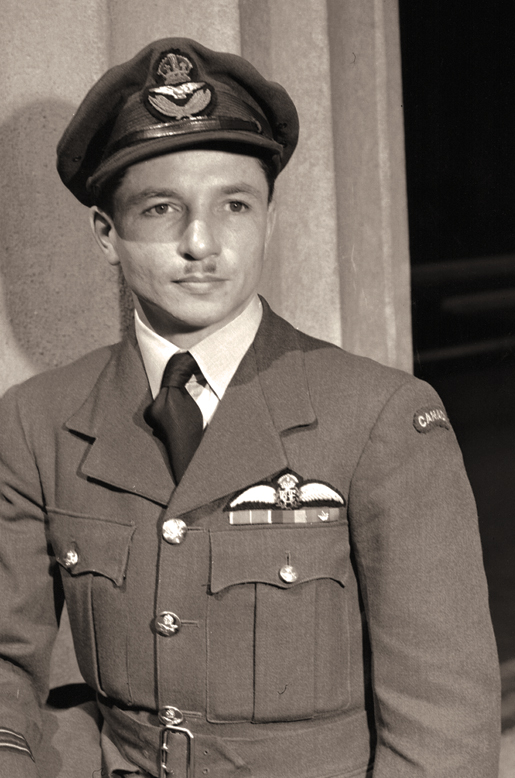
KG600 with 437 Squadron RCAF
Air Britain reports that KG600’s initial unit following ferry operations was 105 (Transport) Operational Training Unit at Bramcote in Warwickshire (2) and that she arrived there only on September 18th 1944. It seems slightly strange that the delivery was to a non-operational unit when the transport squadrons were clamouring for aircraft to support the Arnhem landings. It is possible that further crews for 437 Squadron were trained using the aircraft they were due to fly before posting to Blakehill Farm.
KG600’s first operational flight for 437 Squadron is recorded on September 27th with Flying Officer Errol Semple at the controls. On that day he had already flown KG650 on a 9-aircraft sortie with 437 Squadron accompanying 233 Squadron on a delivery of Typhoon drop tanks to Ypres. The crews were instructed to ‘return with all possible despatch’ to Blakehill Farm. Touching-down at 14:14, Semple and his crew were airborne again in KG600 at 16:45 en route to Matlaske in Norfolk. Here, 437 and 233 Squadrons collected personnel and equipment of the RAF Tempest squadrons 3, 56 and 186 for transfer to B60 Grimbergen, Holland.
On September 29th, 437 adopted the name ‘Husky Squadron’ in recognition of their transport duties. On the same day, KG600 was one of 16 aircraft conveying VIP Officers from Northolt to B56 Brussels-Evere. F.O Semple was Captain of KG600 again with Flt Sgt Macdonald as Second Pilot, Warrant Officer Mackey as Navigator and Warrant Officer Conrad as Radio Operator (4). Glider pilots and paratroops from the Arnhem offensive were carried back to Broadwell on the return leg. KG600 was recorded as ‘FZ600’ in the squadron ledgers (4), an early misidentification which lasted for several months. The ‘real’ FZ600 had been delivered to the RAF in India in January 1944 and crashed in Burma during December of the same year – so it couldn’t have served with 437 Squadron. On the last day of September 1944 KG600 was flown by the same crew on a petrol delivery to Brussels-Evere. The return sortie was scheduled to carry a ‘Top Secret’ load, but it proved to be so secret that it couldn’t be found (5).
(4) Squadron operations are from RAF Operations logs and summaries archived in the UK National Archives.
(5) Eventually, the load of 66 drums of ‘liquid’ was located and 233 and 437 Squadrons carried them back to Blakehill Farm under armed guard on October 1st and 2nd.

During the first few weeks of October 1944, KG600 flew ammunition, petrol and drop tanks to B56, Brussels Evere, returning to the Cotswolds airfields with military equipment and casualties. Mid-month, passengers were conveyed to and from Northolt and ammunition, military spares and maps were delivered to the newly-liberated port of Antwerp. Twenty two aircraft were on strength with 437 Squadron -possibly 21 as KG600 was still recorded as FZ600 on most flights!
Operations followed the same routine during November 1944: stores, mail and passengers to Belgium, France and the Netherlands, casualties back to Broadwell and Down Ampney. The Squadron CO, Wing Commander Sproule, flew KG600 on missions to Juvincourt, Melsbroek and Le Bourget on 14th, 24th and 27th November respectively.
KG600 remained in sustained action during December 1944 with Squadron Leader McVeigh piloting her to B53 Bordeaux with a load of petrol on 1st. For the remainder of the month, flights were operated to B77 Gilze-Rijen, B78 Eindhoven and B70 Antwerp. Some missions were routed via the airfield at Bicester to collect stores; passenger flights were frequently via Northolt. On 11th December, 600 flew from Llandow to Lyons and a further mission to France followed on 15th when she was flown from Melton Mowbray to Toulouse.
1945 begins with very few references to FZ600/ KG600 until January 21st when she is logged flying freight to Brussels Melsbroek. Similar operations are recorded for 22nd (Nivelles) and 27th (also Melsbroek) as the Brussels airfields became the main destinations. A return flight on 28th January conveyed 21 USAAF personnel to Molesworth and was followed by a four-aircraft flight to Eindhoven led by W.Commander Sproule in KG600.
February 1945 saw her identity cemented as KG600 with individual markings Z2 DC also reliably logged. Operations were flown to Belgian destinations on three days as the Allies consolidated their positions ready for the Rhine Crossing. early March saw KG600 moving freight and signals equipment to Brussels and medical supplies from Greenham Common to Le Bourget. Passengers, mail, Canadian nurses and casualties were carried on the return schedules. On March 20th, KG600 was part of a 12-aircraft operation transferring personnel and freight from Perranporth in Cornwall to Brussels Evere. This was the last operation before the twenty four Dakotas of 437 Squadron accompanied their Blakehill Farm neighbours, 233 Squadron to Birch Airfield in Essex in preparation for the Rhine Crossing.
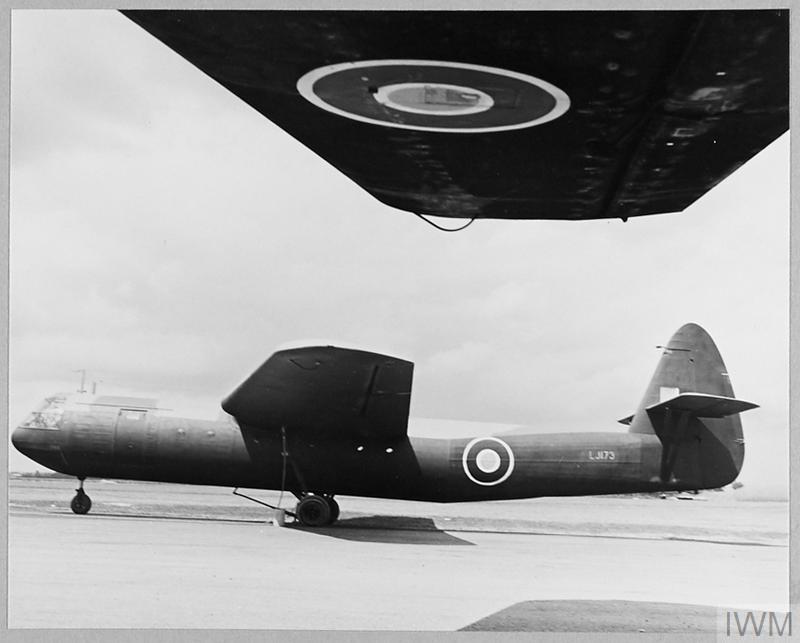
Operation Varsity, The Rhine Crossing, 1945.
Following a combined air test and transit to the Essex airfield on March 21st, briefings for Operation Varsity took place on March 24th. Birch had a 6000′ main runway but had scarcely seen any action since its completion in 1944. As an insurance measure to reassure the Dakota tug and glider pilots, a further 1 mile long, 200′ wide strip of land was cleared at the end of the runway.
On the morning of March 24th, 233 Squadron’s Dakotas took off between 06:18 and 06:49 – an exceptionally swift lift for 24 aircraft towing Horsa gliders. 437 Squadron began their take-off sequence at 07:02 with Wing Commander Sproule in KG600 towing a glider loaded with 14 personnel of 1st Ulster Rifles, their equipment and two trailers. The 46 Group Dakotas from Birch operated in conjunction with C-47s of the USAAF Troop Carrier Command and 38 Group RAF in what was the greatest aerial armada ever seen. The weather conditions were good, flak was encountered but there was no significant Axis fighter opposition on the route to Landing Zone ‘U’ at Hamminkeln. Like most of the troop carriers, 437 found that visibility over the target was slightly compromised by a thick smoke haze laid-down to cover the allied troops as they crossed the Rhine. However, the Horsas were released on target and the 24 Dakotas of 437 headed for Brussels Nivelles for refueling. Four of the Dakotas had sustained slight flak damage but none was seriously damaged. The Squadron stood-by at Nivelles in case reinforcement was needed but the allied forces encountered less opposition than feared and the Dakotas returned to Blakehill on March 26th. KG600 flew one further mission in March 1945. a freight flight to Brussels Nivelles returning with 20 of the Varsity glider pilots on March 30th.

Closing Days of WW2.
April and May 1945 saw the allies rapidly advancing across Germany as the war drew to a close. KG600 continued regular work with 437 Squadron ferrying freight and passengers between the Low Countries and southern Britain. Flt Lt Payne and Second Pilot J.C. ‘Tip’ Holborn flew medical supplies for the Dutch to Nivelles on April 4th before flying on to the Advanced Landing Ground B100 Goch (Laarbruch) in Germany. The flight returned via Brussels Evere where 12 passengers were embarked for Croydon and 23 for Blakehill Farm – a lot of passengers. A similar routing on April 6th brought casualties from Goch to the RAF hospital in Brussels. In between these operations, KG600 made a training flight to Belfast/ Nutts Corner on April 2nd and a shorter one to Northolt on April 5th. From April 9th onwards, KG600 was making further flights to German destinations almost every day.
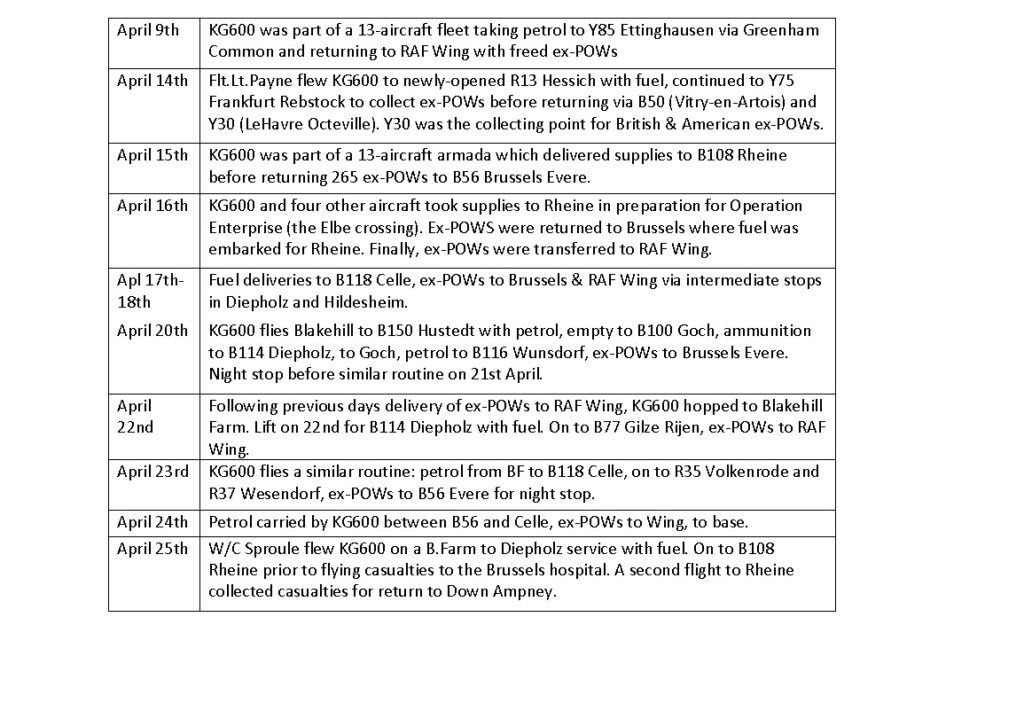
Operations in the first week of May 1945 followed a similar pattern to April, one which was in parallel to 233 Squadron RAF’s missions, also flown from Blakehill Farm. Petrol was transported to the Continent, ex-POWs and casualties back to RAF Wing and Down Ampney. Shuttle flights sometimes lasted several days with B111 Ahlhorn, B114 Diepholz and B118 Celle popular destinations. Copenhagen was added as a new port-of-call following its liberation on May 4th 1945 and 437 Squadron assisted delivering a German delegation to Rheims for peace negotiations as the end of the War approached.
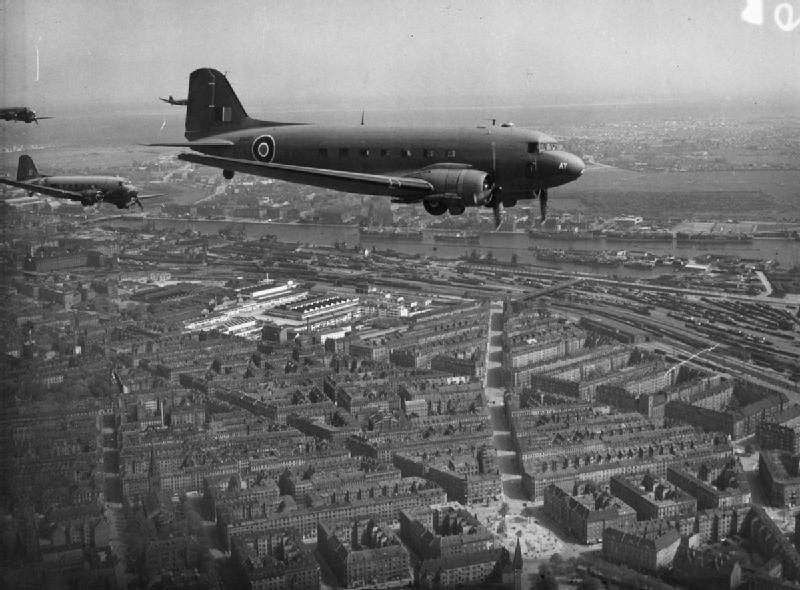
The role of 437 Squadron delivering stores to European air bases and assisting with the repatriation of ex-POWs had been well-established and KG600 took an active part. 233 Squadron had operated an eight-Dakota detachment at Brussels Nivelles from January 1945 and, on May 7th, 437 Squadron was transferred in its entirety to Nivelles where they were attached to 111 Wing. Services continued to transfer RAF personnel and stores to forward airfields, ex-POWs back to Dunsfold and the Dakotas were returned to Blakehill Farm for servicing. 437 Squadron also played an important part in repatriating ex-Concentration Camp prisoners from the notorious camp at Bergen-Belsen. From mid-April through May 1945, KG600 flew as part of 437 operations to B118, Celle, the closest allied airstrip to Belsen. The Squadron flew senior allied officers to Celle to enable documentation of the horrors of Belsen. Return flights were reported to sometimes accommodate up to 100 freed Holocaust survivors (6).
On May 10th, a 437 Dakota flew senior German officers from the Nazis final HQ at Flensburg to Rheims for surrender negotiations. The 437 Squadron flights to Oslo and Copenhagen were also used to transport German officers to Edinburgh Castle via Drem airfield as part of a peace delegation. The end of May saw the squadron operating 21 Dakota IIIs and 4 Dakota IVs on flights carrying Russian and French ex-POWs and Displaced persons between airfields such as Lille, Luneburg, Le Havre and LeBourget. 438 sorties were flown during the month accounting for 3348 flying hours.
(6) Karen Black, daughter of a 437 Squadron Dakota pilot, wrote an informative short piece on RCAF involvement in liberating concentration camp inmates: Toronto Star April 11th 2021.
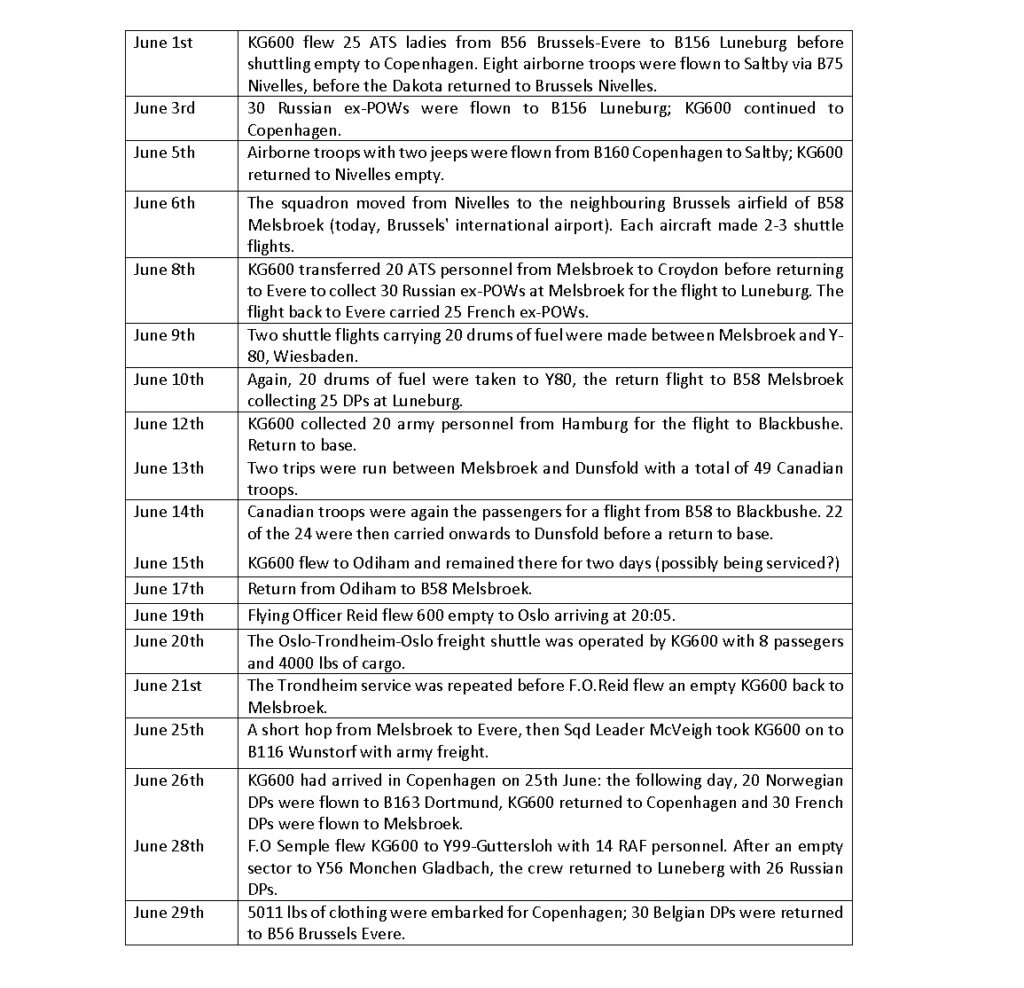
437 Squadron operated some regular services during the summer of ’45: three aircraft were allocated to Oslo, taking over from a detachment of 575 Squadron RAF. The ‘Yeast Run’ was another regular operation from Melsbroek to B61 Sint Denijs and then on to Y94 Munster, B158 Lubeck and Gatow- it kept the bread ovens of the Occupied Zone running.
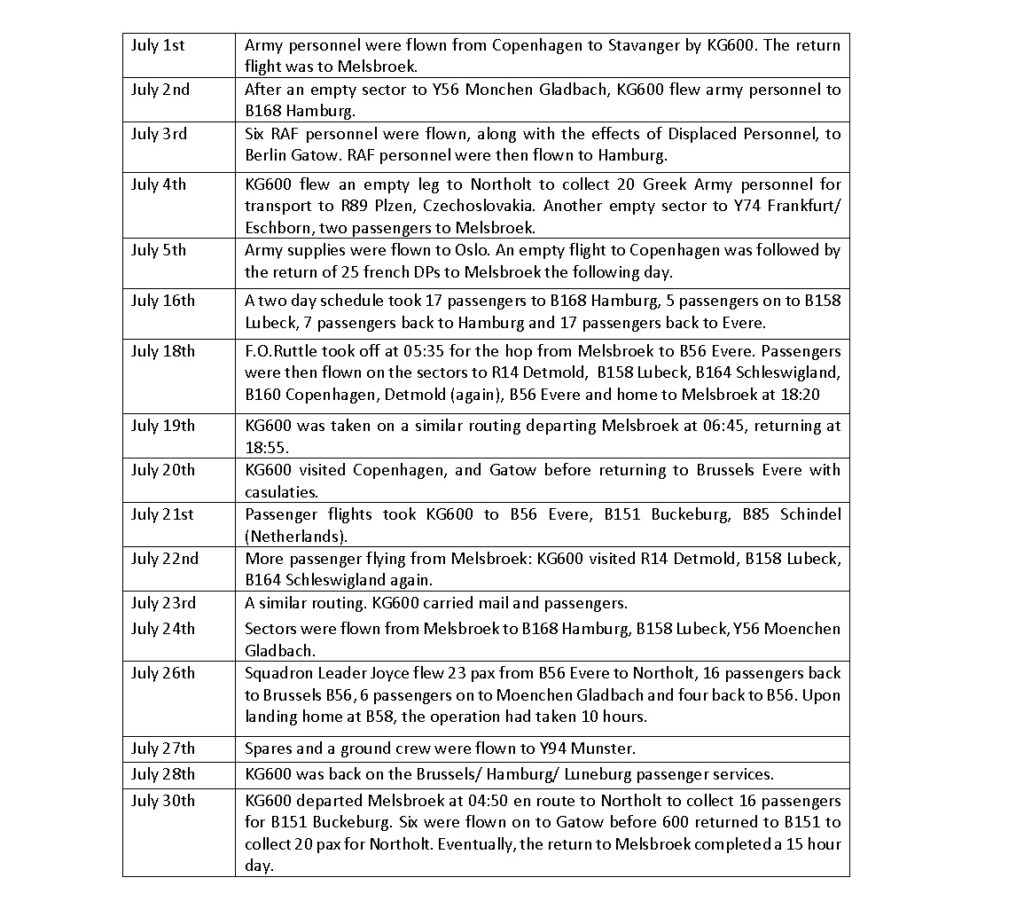
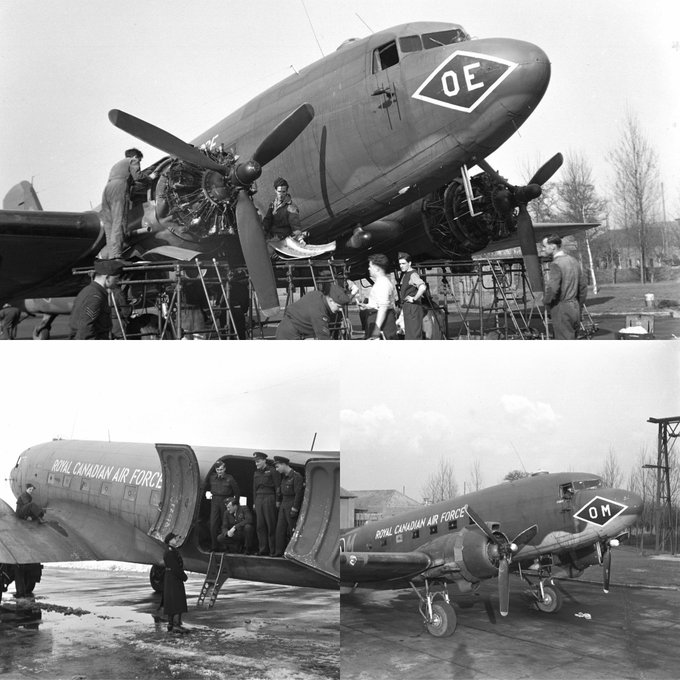
During August 1945 the main squadron remained at Melsbroek under the command of W/C Sproule but a four-aircraft detachment returned to the UK and the Hampshire airfield at Odiham. KG600 departed B58 Melsbroek on August 2nd to collect 2548 lbs of freight for Farnborough. From there, KG600 flew the short 12-mile hop to join the ‘A’ flight detachment at Odiham. The following day, August 3rd, KG600 positioned to Northolt ready to transfer 17 passengers to B151 Buckeburg before transiting to Gatow to collect Northolt-bound passengers. On August 8th, it was Croydon which provided the 4430 lbs of freight destined for Hamburg. The return leg was flown empty. August 11th produced a 5010 lb cargo of meteorological equipment for Melsbroek. A positioning sector to B150 Hustedt was flown empty in order to collect 16 casualties bound for Melsbroek and seven destined for Down Ampney. When KG600 landed home at Odiham it was at the end of a 13 hour day.
By August 14th, KG600 had been allocated to Norwegian destinations: 5000 lbs of freight were collected from Boreham, Essex, for delivery to Stavanger. 3800 lbs were then hauled to the night stop at Oslo. Five passengers were returned to Croydon the following day. A similar route was flown on 17th August in the company of KG568 and KG310. Freight was delivered from Boreham to Oslo and KG600 flew on to Trondheim the following morning. After 2 hours on the ground, she took-off for a 3.5 hour sector to Bardufoss, near Tromso, in northern Norway. On August 19th KG600 returned to Oslo with passengers and freight before setting off for Northolt with further personnel and cargo. There was a break from Scandinavian operations on August 22nd when KG600 operated a 13-hour mail flight day carrying 2664 lbs to Buckeburg, 2175 lbs onwards to Gatow, 2760 lbs back to Buckeburg and then passengers and casualties back to Down Ampney. Twenty passengers were flown outwards from Northolt to B110 Achmer on August 26th, eighteen passengers were carried on the return.
KG600 continued to fly from Odiham with ‘A’ flight during September 1945. Destinations were slightly more diverse with Rome and Marseille visited early in the month followed by a mission from Boreham to Prague, returning via Frankfurt. Oslo and Buckeburg remained regular ports-of-call. the main squadron at Melsbroek was finding that most operations were from B56 Evere and Melsbroek was being relegated to a parking airfield. Consequently, on September 15th, the main part of 437 Squadron moved to Evere. Two days later W/Cdr Sproule was posted to RCAF Headquarters and his command was taken over by W/Cdr A.Holmes.
British forces operated from three separate Headquarters in Germany and it was decided to open an airfield which served all branches. B151 Buckeburg in Lower Saxony was completed in 1946 to serve as the destination for British Forces mail and personnel in Germany. Prior to this Buckeburg had been an Advanced Landing Ground frequently visited by the 437 Squadron ‘postman’ and, during October 1945, the Squadron moved two aircraft and three crews there. After a return Odiham to Melsbroek service on October 1st, KG600 flew 8 passengers from Odiham to Buckeburg on 9th followed by a return shuttle flight between Buckeburg and Gatow later the same day. The shuttle to Berlin was repeated on 10th, 14th, 17th and 20th October with a return Buckeburg to Evere and Monchen Gladbach slotted-in on 15th.
November 1945 saw 437 Squadron consolidating operations at Odiham with most of the B56 Evere aircraft flying to Hampshire on November 17th and 18th carrying the Squadron’s HQ staff. While a detachment remained at Evere, the Oslo detachment also moved to Odiham on November 28th. With the end of the war, five 437 crews were able to return to Canada during November. Other changes during the autumn included the arrival from India of 435 and 436 RCAF transport squadrons. They moved into 233/ 437’s old base of Blakehill Farm and operated some of 233’s Dakotas once these had transported 233 personnel in the opposite direction to Imphal. 271 Squadron RAF Dakotas joined 437 Squadron at Odiham. In recognition of their post war primary function, fifteen of 437’s Dakotas were equipped with proper passenger seating.
KG600 had a very quiet December and even less of her is recorded during January and February of the New Year. On December 7th, F.Officer Chow flew KG600 from Evere to B93 Valkenburg with 16 passengers before heading on to Copenhagen with mail and passengers. After a night stop in Denmark, 600 was flown onwards to B164 Schleswigland before retracing footsteps to Valkenburg and Brussels Evere. It looks like KG600 remained with the Evere detachment during December 1945 as the next flight, on December 9th, was from Brussels to Copenhagen with a single passenger. December 10th saw KG600 flying on to B168 Hamburg and B151 Buckeburg before returning to Evere. On December 12th, the Buckeburg route was repeated. During much of the month, 437 Squadron flew six to seven sorties a day including a daily service which had been inaugurated between Odiham and Nuremburg to support the War Crimes Commission.
KG600 resurfaces again in March 1946 with a series of flights from Odiham to southern France and Italy. By March 20th, the Buckeburg detachment had returned to the UK and a new detachment had been established at Croydon under Squadron Leader Strange. Although a further detachment was proposed for Hamburg, the Evere detachment rejoined the main squadron at Odiham.
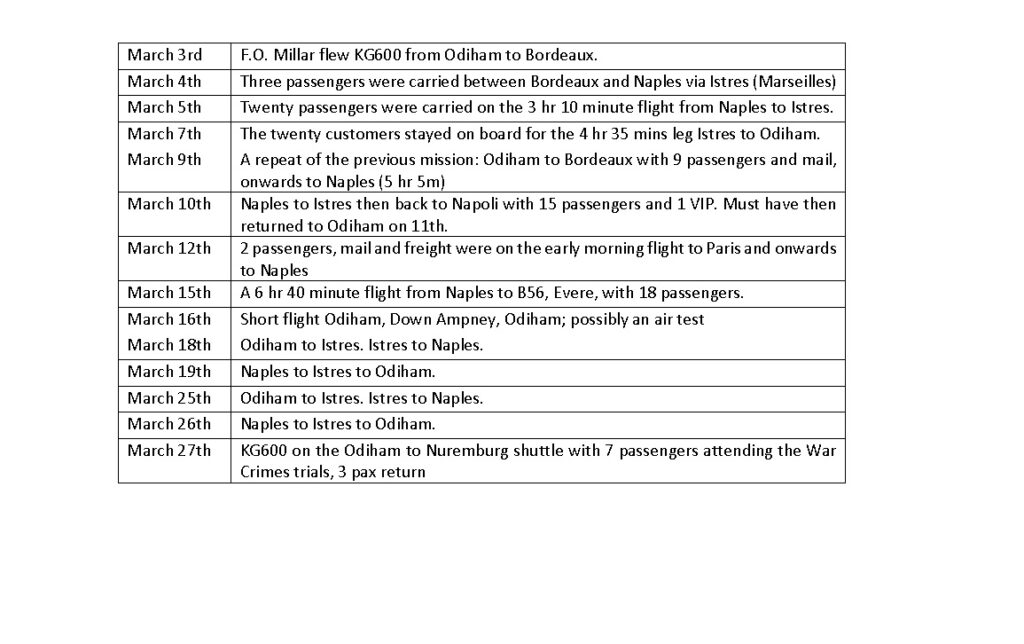
On 1st April 1946 eleven crews started training at Down Ampney in preparation for flying their Dakotas back to Canada. The Atlantic crossing was due to commence on April 16th from Down Ampney and, following their departure, there was no further flying from Odiham during April. However, 437 Squadron aircraft did continue to fly from both Hamburg and Croydon during the month with the German detachment not returning to the UK until May 31st. With the news that 437 Squadron would be disbanded during June 1946, sixteen crews were trained-up for the final flight back to Canada. Briefings commenced on June 4th, air tests and compass swings were conducted on June 5th, fuel consumption tests on June 6th. An air sea rescue exercise briefing was held on 7th June prior to a two-day break for Victory celebrations in London. A farewell party was held in the Mess on 14th June and eight Dakotas, led by Wing Commander Holmes, departed the following day: KG545, KG632, FZ692, FZ669, KN291, KG345, KG577 and KG395. Squadron Leader Miller led the final seven aircraft when they departed on 16th June: the Squadron had been disbanded. The final seven Dakotas were: KG568, KG354, KG389, KG312, FZ694, KG602 and KG368. As KG600 is not recorded as being part of the ‘Final Fifteen’, it seems likely that she departed for Canada in April 1946 along with FZ695, KG330, KG634, KN256, KN269, KN278 and four others. This tranche of Dakotas was assigned to new units in Canada from April 22nd.

North American Days
The Canadian government had supported the establishment of Trans Canada Airlines as a subsidiary of Canadian National Railways in 1937 and, post war, sought to promote TCA as both the national and international face of Canadian aviation. The supply of ex-RAF/ RCAF Dakotas seemed to offer a good option for domestic freight and passenger services. Thirty-odd Dakotas were transferred to TCA with initial batches assigned in December 1945 and February 1946, many after upgrading and civilianisation by Canadair. This was clearly before the Dakotas returning from Europe had crossed the Atlantic and the assignment was filled with C-47s which had served in Canada during the war. The consignment of aircraft arriving in Canada from overseas service with 435, 436 and 437 squadrons therefore became the backbone of the RCAF Dakota fleet, often for long and distinguished careers.
KG600’s first operator in Canada is recorded as being No. 9 Transport Group at Rockcliffe, Ontario (1). In August 1946 she is reported to have been loaned to Trans Canada Airlines for six weeks prior to entering storage at Weyburn, Saskatchewan (7). By September 1947, KG600 had been modified at #10 Repair Depot at Calgary to enable target towing operations with Training Command at Trenton, Ontario. In early 1952 she was delivered to Canadair for upgrading to Search & Rescue duties. A wheel/ ski configuration was facilitated and JATO capabilities added to qualify her for the RCAF’s ‘Dakota 3 SR’ designation. KG600 was posted to RCAF Maritime Group at Greenwood, Nova Scotia. Aircraft industries Ltd inspected the aircraft in August 1953, apparently following accident damage, and the airframe was allocated to #2 Technical Training School, Camp Borden, Ontario on 13th April 1954. By then, the original ‘KG600’ serial had changed to ‘601B’. Finally, the aircraft moved west again to Winnipeg, Manitoba, on 9th November 1955. A601B remained there until she was demobilised in August 1958 (8).
(7) Air Britain British Civil Aviation News, February 22nd 1964, suggests that KG600 went to TCA in August 1946 but ‘The DC-3 and its Predecessors’ quote 17th June 1946.
(8) One unsubstantiated story claims that KG600 spent some time flying for the RCAF as transport for senior personnel, including the Canadian Chief of Air Staff.
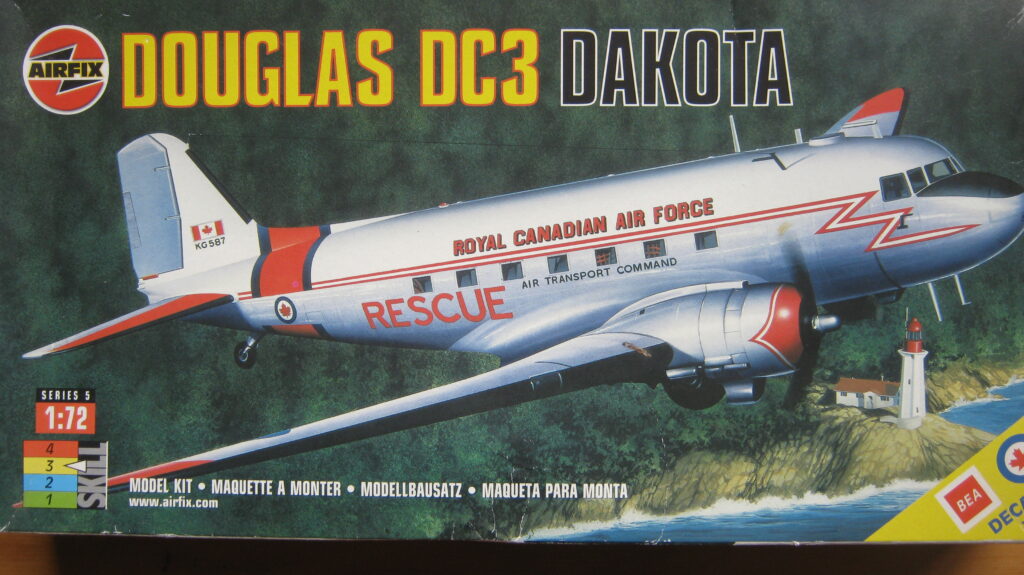
The first civil owner for KG600 is recorded as the Beldex Corporation, an organisation associated with Remmert-Werner of St.Louis. This company had developed a specialisation for converting ex-military aircraft to executive transports. They had modified their first C-47 in 1946 and, by the mid fifties, had a long list of successful conversions. They were not the only company pursuing this line of business: AiResearch, Canadair and Scottish Aviation were all experts too. And the financial aspects were very favourable: by the late fifties, an ex-air force C-47 could be converted and sold for between $150,000 and $260,000 (9). The problem being experienced increasingly towards the end of the decade was that the supply of suitable conversion candidates was drying-up. Aircraft which had been out of commission for years were being snapped-up by Remmert-Werner from all over the World, so the purchase of an ex-instructional airframe from mid-Canada is not as unusual as it might initially seem. One major benefit offered by A601B was that its instructional role had ensured low flying hours (believed to be around 6300 when sold by the RCAF).
Remmert-Werner’s improvements included up-rated engines, improved avionics, a one-piece windshield, air stairs, better insulation, heating, seating, galley and toilet facilities. New electrics, undercarriage doors, hydraulics, anti-icing and safety upgrades were often combined with Remmert’s trademark panoramic windows. These large windows in the passenger cabin (see the thread on ‘Flabob Express’) were not installed in KG600/ A601B when she was converted to her new identity as N96U in the Spring of 1959. She was, otherwise, an extensively modified aircraft well-equipped for many years of flying. With a Remmert-Werner identity plate giving the conversion date as March 1st 1959, she was delivered to her new corporate owners, the Freeport Nickel Company, at Pompano Beach, Florida.
(9) Details from Douglas J. Ingells ‘The Plane that changed the World’, Aero Publishers 1966. Similar figures for Scottish Aviation quote post-war purchase prices of ex-service Dakotas of a few thousand dollars in the mid 1940s. Their tariff offered civilianised freighters for £10,500 to £13,500 but executive models for £30,000 to £40,000 (‘Just one of the Pioneers’, William Neil, Cirrus, 2002).
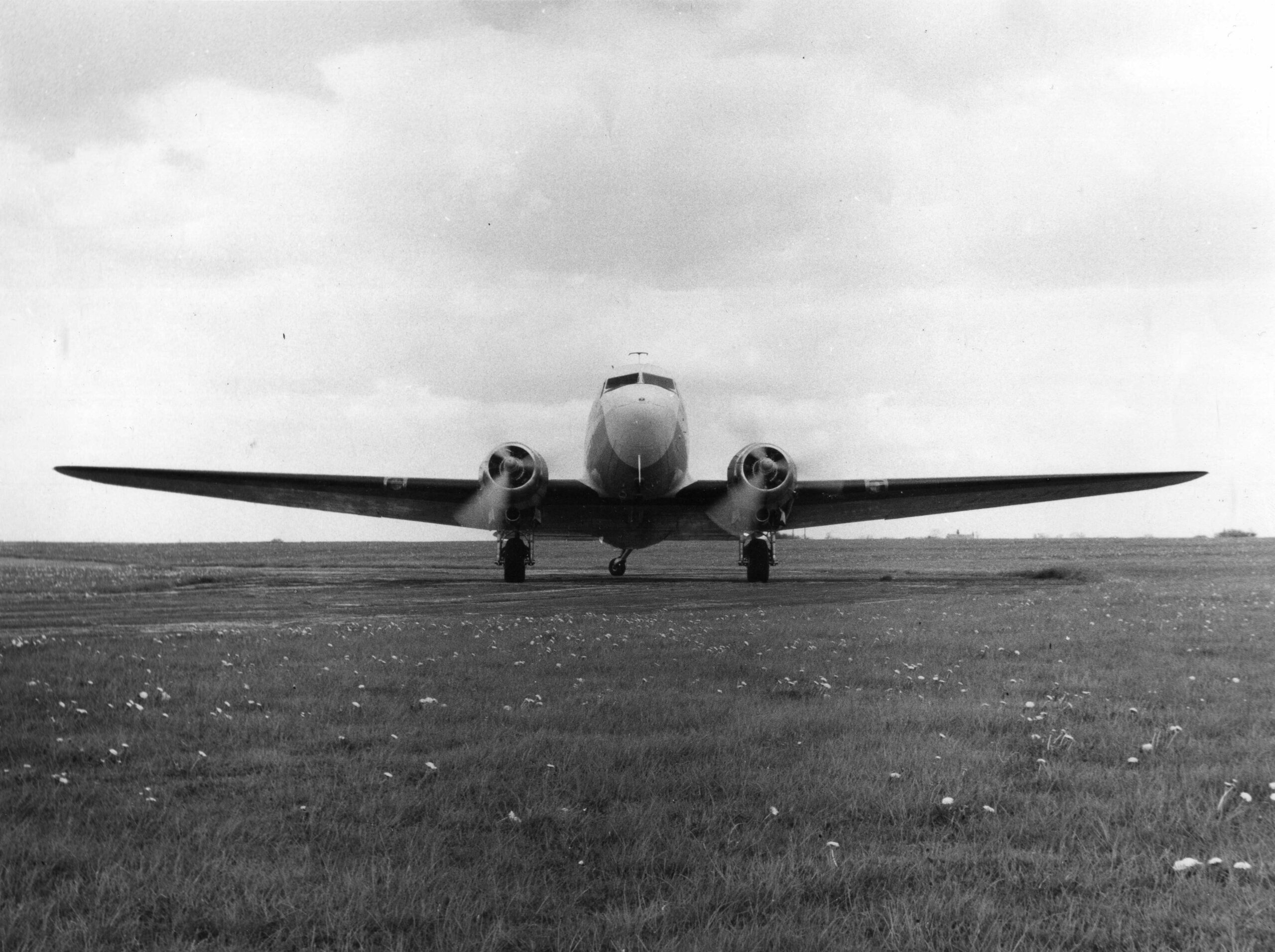
Cuban Daze
The aircraft’s new owner, The Freeport Nickel Company, was a wholly-owned subsidiary of the Freeport Sulphur Company, a mining giant founded at Freeport, Texas, before World War 1. Following the move of the corporate HQ to New York in the 1930s, the Company diversified into two Cuban-based operations, a manganese oxide operation in Oriente province followed by the Nicaro Nickel Mine at Banes. While the Company’s huge Louisiana sulphur deposits guaranteed a rich income, they had also struck a generous fixed-price war time deal for their nickel production. Post-war, the US Government dropped the price guarantee and the Cuban nickel operation couldn’t make money in an open market. This changed during the mid-fifties when new techniques to extract cobalt and nickel led to a resurgence in the Cuban operations. In 1955, Freeport formed the Moa Bay Mining Company as a subsidiary of their Cuban American Nickel Company. Under the regime of Cuba’s President Batista, Freeport constructed a new town at Moa Bay, Oriente Province where it was believed that nickel reserves might constitute two-thirds of the World supply.
N96U’s airborne operations are therefore likely to have covered the US Gulf Coast with regular flights to Cuba. The Dakota was transferred to the Cuban registry in May 1959 with a registration quoted as CU-P-702, later CU-N-702 (1). However, while enjoying the approval of Batista’s military government, this was almost guaranteed to trigger the opposite sentiment from the post-revolution government of Fidel Castro. Batista had fled Havana on January 1st 1959 so, by the time Freeport’s C-47 joined the Cuban registry, the writing was on the wall for the mining company. New mining laws were invoked in November 1969, just ahead of the start-up of the Moa Bay mine and, in April 1960, the Company halted production. Freeport lodged a confiscation claim for the mine of almost $90 million – equivalent to $831 million in 2022 terms (10). As a result of the upheaval, the Dakota was re-registered in the USA in March 1960 following a conformity inspection by Pan Air of New Orleans on 6th of the month. The newly-adopted N702S registration appears to have minimised the use of paint! Service with the Freeport Sulphur Company continued for another two and a half years before sale to the International Telephones and Telegraph Corporation. The Pan Air Corporation repeated their inspection of N702S prior to the sale to ITT and noted that her years on the Gulf Coast and the Caribbean had yielded some corrosion although this had, fortunately, been minimised by Remmert-Werner’s chromate paint finish (11). N702S’s total flying time upon sale to ITT was 7051 hours.
(10) Inflation figure from the 2013dollars.com website. Given the rise in Nickel values, this could be interpreted as closer to $9 billion in 2022.
(11) Air Britain’s British Civil Aircraft News’ correspondent added further sensational information that N702S’s days in Cuba had added a number of small-calibre bullet holes to the aft fuselage. Alternatively, these may have been supplied by the Wehrmacht in the 1940s.
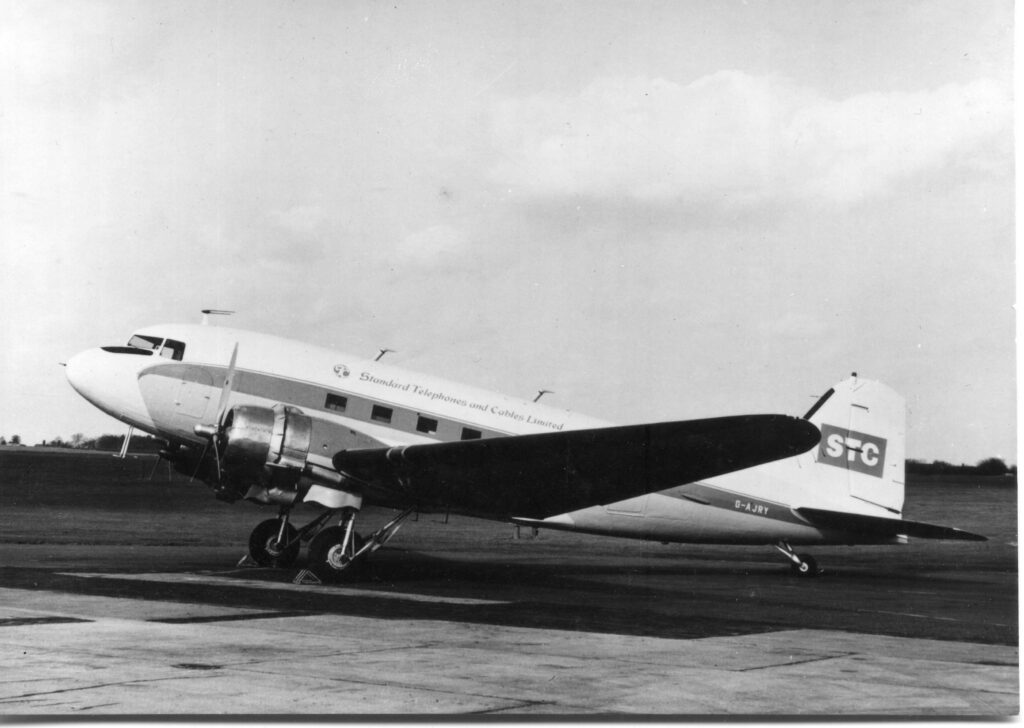
ITT had purchased a subsidiary company in Britain in 1925 and, in the early 1960s, Standard Telephones and Cables was controlled by a Texan Chief Executive. It was decided that an executive transport aircraft would benefit operations within Europe and the transfer of N702S to London was arranged with ITT.
Stolen Identities:
UK registered Dakotas had generally joined the UK civil register from RAF service in large tranches as from the 1950s. The (G-A) ‘G’, ‘H’ and ‘M’ letters were particularly rich with ex-service Dakotas but, by the time the register had reached the G-APxx allocations, the number of Dakotas joining the UK civil scene had dropped to a mere handful. Imagine the excitement of enthusiasts when late 1962 produced the potential new arrival of Standard Telephones and Cables corporate DC-3 ready to settle into the G-AS** registration block! For ITT, a corporate aircraft required a personalised identity and the imminent allocation of the UK registration G-ASTC seemed too good an opportunity to pass-up. Britain, however, did things differently from the USA and the Air Registration Board seemed unlikely to cater for such whimsy. But nothing venture, nothing gain and STC duly enquired whether they might be able to claim G-ASTC for their DC-3. Amazingly, the initial reaction seemed positive with no mention of any fee or charge (in the 2020s, out-of-sequence registration has become a frequent occurrence for a mere £316). But it was not to be…one version suggests that STC sent the helpful ARB personnel chocolates and a bouquet of flowers and this was considered to be open to mis-interpretation as an incentive. Others have commented that the higher echelons were anxious to avoid precedents. Either way, the recently-arrived aircraft was allocated the registration G-ASDX and the identity was painted onto N702S on 19th November 1962. Within a week, with the paint barely dry, and aviation historian had noted that the serial number 13331 appeared to have already been on the UK register. Indeed British Aviation Services’ G-AJRY had been registered on 9th June 1947 quoting the (incorrect) serial of 13331. More recent research (1) shows that this aircraft was 13336 and was briefly G-AJRY as she passed from RAF usage as KG607 to a far eastern home with Malayan Airways. The ARB was, perhaps, a little sensitive to any criticism by now and, upon being informed, re-registered STC’s Dakota as G-AJRY. The log book shows G-ASDX over-stamped with G-AJRY and today’s G-INFO website shows 13366 as ‘G-AJRY-1’ and 13331 as ‘G-AJRY-2’. Incidentally, G-ASTC was eventually issued to a Piper PA-28 of Thurston Engineering in May 1964. The registration G-ASDX, meanwhile, was due to be re-allocated to a Piper Comanche before finally being re/re allocated to a Piper PA-23 Aztec of CSE at Kidlington on 6th December 1962. Dogged by ill-luck, the registration was cancelled as ‘not imported’ on 28th January 1963 and never reappeared. If the ARB had been sticklers for detail (or, perhaps, gluttons for punishment) the record could have been set right at anytime after January 1963 by confirming the STC DC-3 as G-ASDX.
The earlier confusion during the Dakota’s service with 437 Squadron (FZ600 or KG600?) paled into insignificance compared with this new controversy. Questions about her identity were enough to set typewriters chattering from Malaysia to Manchester. Nonetheless, STC’s new baby remained registered as G-AJRY and, for many years, plied the skies of Europe from her base at Stansted using this (incorrect) identity.
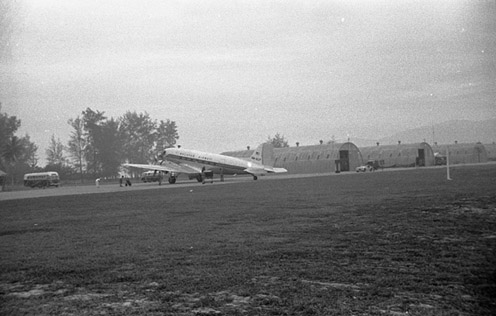
STC Corporate Operations:
N702S was originally received by ITT’s US subsidiary, Federal Electric Corporation. She departed Teterboro Airport, New York, on 18th October 1962 and transited the Atlantic via Gander and Shannon to arrive at Stansted on October 26th. The following day, she flew to ITT’s European HQ at Brussels still carrying the US registration – the same day, coincidentally, that President Kennedy’s Joint Chiefs of Staff recommended that the USA should attack N702S’s old home of Cuba within 36 hours. On October 28th, N702S flew on from Brussels to Zurich and Lugano before returning to Stansted via Brussels. The last two days of October 1962 were spent on day and night training flights from Stansted.
By November 2nd 1962, N702S was at Renfrew Airport, Glasgow, and Turnhouse Airport, Edinburgh. Five days later she visited Manchester’s Ringway Airport, still carrying the US registration (12). Official registration as G-ASDX took place on 19th November and, by 21st, she had been painted appropriately. G-ASDX was reported to be testing new STC-designed landing aids at Bournemouth Hurn on November 21st in the company of a USAF C-117 (0-51135) and Flight International’s Airedale photo ship G-ARXD. She was noted at Heathrow later the same day and departed for Liverpool that evening. After a night stop at Speke, ‘DX headed for Prestwick the following day, November 22nd. By November 28th, the Dakota had been noted at Heathrow wearing her new identity of G-AJRY and was back in Prestwick by December 4th. The colour scheme remained much as it had been in the USA with the fin having a pale blue leading edge to match the main cheat line.
(12) Airport movements from Air Britain publications for 1962 and 1963.
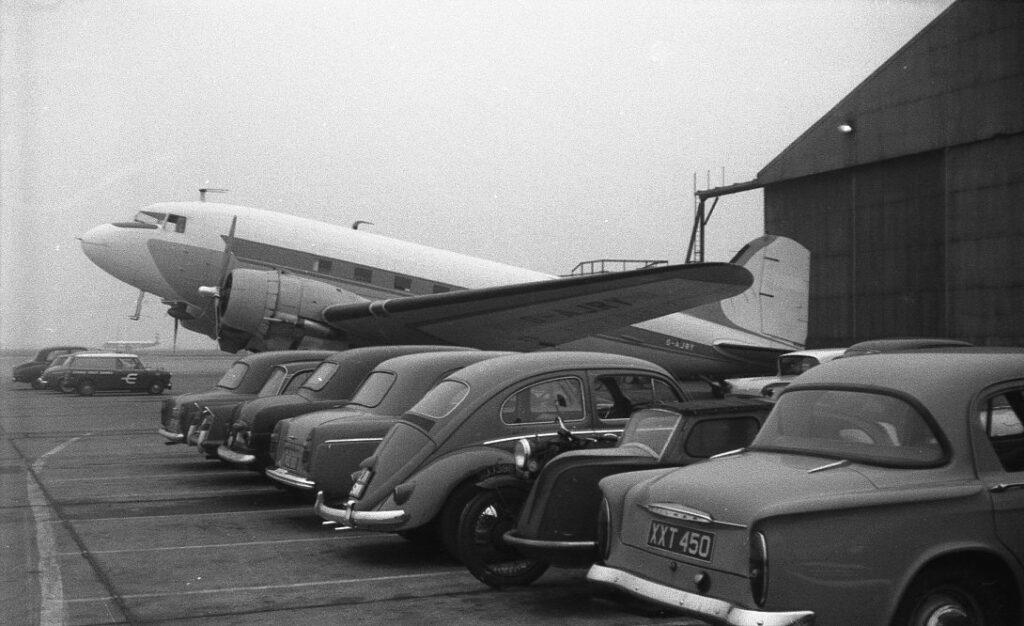
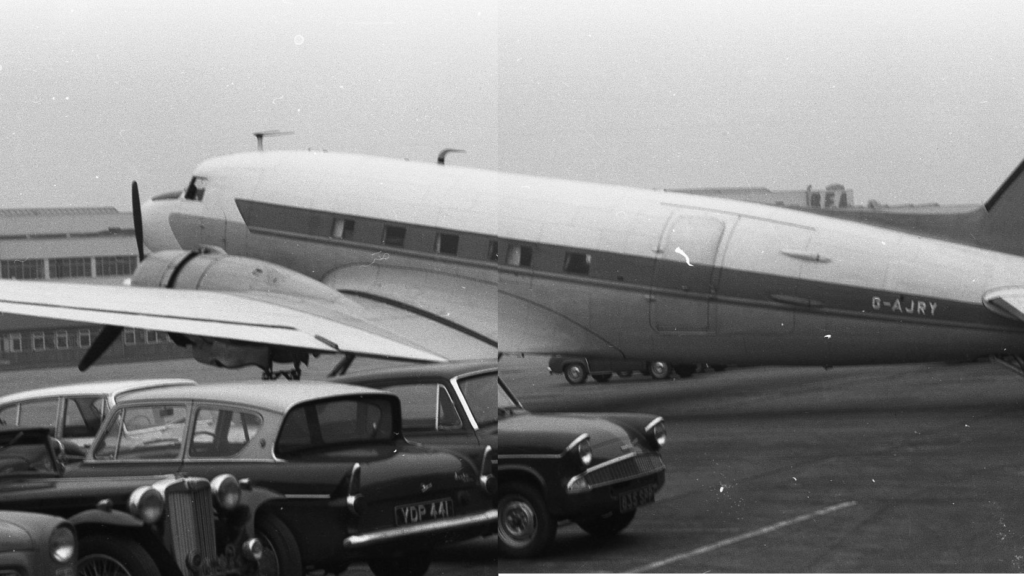
G-AJRY’s operational duties were split between executive personnel transport and occasional test bed functions. STC produced a range of avionics and already owned the fuselage of Dakota KG611 which had been written-off by the RAF following a landing incident at Castle Donington in August 1945. KG611’s remains were employed at the Company’s Southgate factory to experiment with the location of radio and navaid antennae. A regular task for G-AJRY was the transport of executives to the monthly ITT (Europe) board meetings in Brussels on the first Monday of each month.
STC owned a villa in Catalonia which was used for recreational incentives and the Dakota made frequent journeys to Perpignon carrying lucky employees on holiday. Other corporate functions included flights to trade exhibitions: an early operation saw STC staff transported to Speke Airport on May 3rd 1963 for a Liverpool Corporation symposium. Later in the month, she was spotted all over Britain with calls at Renfrew on 10th, Manchester on 22nd and Exeter on 23rd. During June, visits were made to Inverness (June 1st), the Glasgow area on 19th and on August 30th ‘RY was at Leeds/ Bradford Airport. By way of confirmation that STC’s Dakota really shouldn’t be G-AJRY, the original G-AJRY was noted during the summer in service with Malayan Airways as 9M-ALO at Kuantan (Malaysia) on May 21st, Butterworth (May 31st) and Paya Lebar, Singapore, on September 17th.
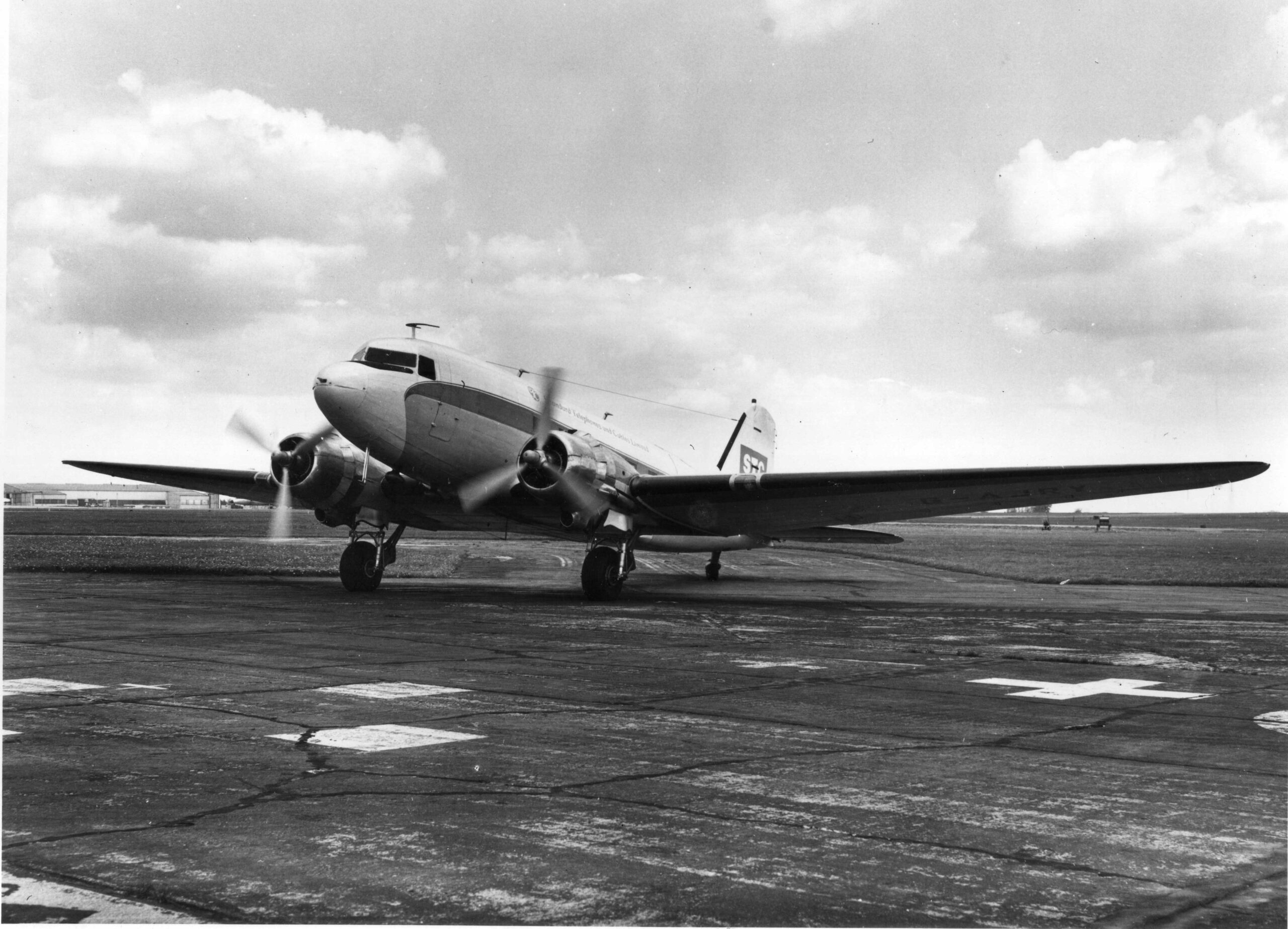
G-AJRY had a dedicated hangar at Stansted Airport at the western end of the main runway, away from both the original terminal and the Aviation Traders facilities. The hangar later passed to Ford Motors for its executive fleet. Maintenance was largely carried-out by a single dedicated engineer which probably accounted for the aircraft’s immaculate condition. Annual flying hours were around 750 to 800 during the mid-sixties and the routine Check 1 and Check 2 maintenance was completed locally by Aviation Traders. In eight years of operation, ‘RY completed over 7000 flying hours with only one incident: a cracked cylinder on the starboard engine on 7th september 1969 led to a single-engine landing at Paris Le Bourget during a flight to Milan. STC’s flight crew was also very established with the Company’s Chief Pilot, Captain Hare, taking the left hand seat and his wife working as the Cabin Attendant (13).
In late December 1968, Aviation Traders completed the conversion of G-AJRY from a Dakota 4 to a Dakota 3 while carrying-out a CofA renewal and Check 2 inspection. The Twin Wasp 1830-90 engines were switched for 1830-92 units.
(13) I visited Captain Hare at his cottage in Henham, near Stansted, in autumn 1972 and he supplied much of the operational detail regarding STC operations.
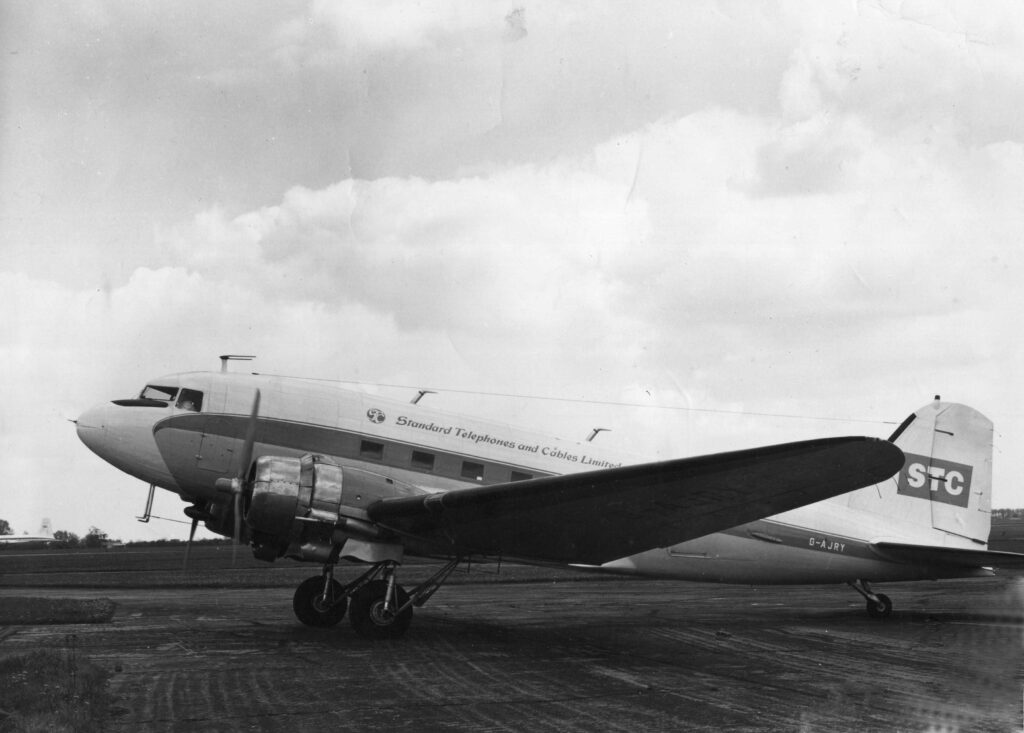
G-AJRY’s test bed function expanded during the late sixties as STC worked in partnership with SAAB to develop a contour-following radio altimeter for the Swedish company’s Draken fighter. The equipment being trialed was installed in place of the navigator’s table and a series of tests was completed at the RAE’s Bedford test range and RAF Boscombe Down. Promotion of the equipment also saw G-AJRY making frequent flights to Sweden in 1969 with visits to Malmo, Linkoping and Norrkoping as well as the more frequent destinations of Stockholm, Oslo, Helsinki and Copenhagen. The radio altimeter package worked well over land but experienced problems flying over calm waters such as the Swedish Lakes. A ‘double blip’ could confuse the processing of the altitude information. G-AJRY was despatched to seek areas of calm water to further investigate the problem. After a series of flights around the coast of East Anglia in August 1969 and a call at Yeovil on 11th, a suitable location was discovered off the Cornish peninsula. However, the anomaly was close to resolution by then and little further flying time was spent on the project.
STC had evaluated potential replacements for G-AJRY over the years with the Handley Page Herald, HS125 and HS748 all considered but found to be wanting. By March 1970, ‘RY’s monthly flying hours had dropped to only 4.5 hours, a mere 257 hours over the preceding 12 months. Utilisation rose briefly during Summer 1970 but ITT had acquired a jet for use by its European subsidiaries and the Dakota was virtually redundant. There was a minor difficulty feathering the port Hamilton Standard in February 1970 but, by March 10th, the Dakota was back at work testing Doppler ILS equipment. Nonetheless, annual times remained below 200 hours and, with the closure of STC’s Flying Division, the aircraft was ready for sale.
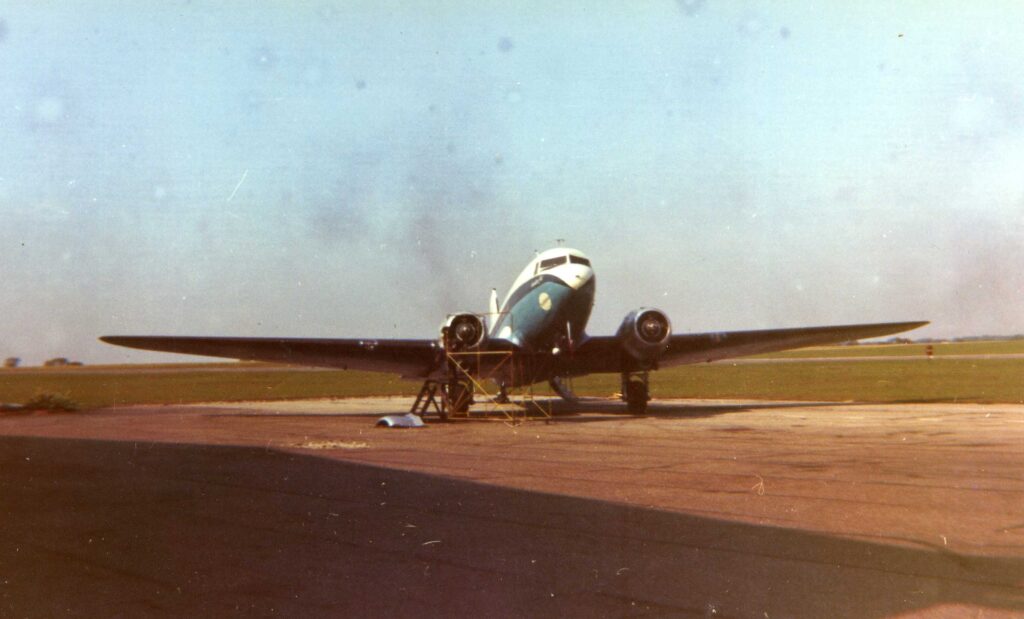
STC didn’t have to look far for a new owner; TD ‘Mike’ Keegan’s all-freight outfit, Transmeridian Air Cargo (TMAC) operated CL-44Ds from Stansted and he wasn’t a man to ignore a good aviation deal. As an experienced pilot himself, Mike Keegan took a type-conversion flight with Captain Hare on June 20th 1970 and a fortnight later, July 3rd, the Dakota was officially transferred to his ownership.
With a long history of airline operation stretching from Crewsair to BKS to TMAC, Mike Keegan had also been a major force in aircraft sales, conversions and engineering. He had kept a series of aircraft for use as private and company ‘hacks’ and G-AJRY was seen as a vehicle for overseas sales promotions, ferrying of slip crews and spares transport. When STC sold the Dakota, it had logged 14,717 hours. During the Transmeridian years, routine maintenance was carried-out at Stansted by the airline’s engineers while any more extensive work was parceled-out to Field’s at Castle Donington.
TMAC were keen to promote their long-range CL-44D freight operations and an early mission for G-AJRY was an extensive sales trip to East Africa during the second half of 1970. Some damage was sustained to one of the wing tips during late 1970 and the aircraft flew to Field’s for an X-ray of the starboard wing. Prior to this, radiographic tests had been carried-out on STC’s behalf in January 1968 and close checks were made on any development of the post-Cuba corrosion.
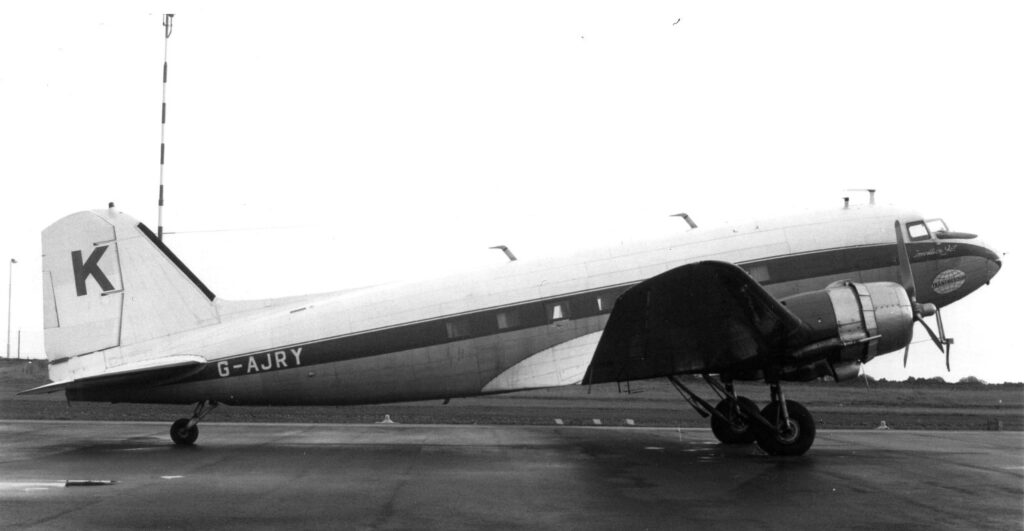
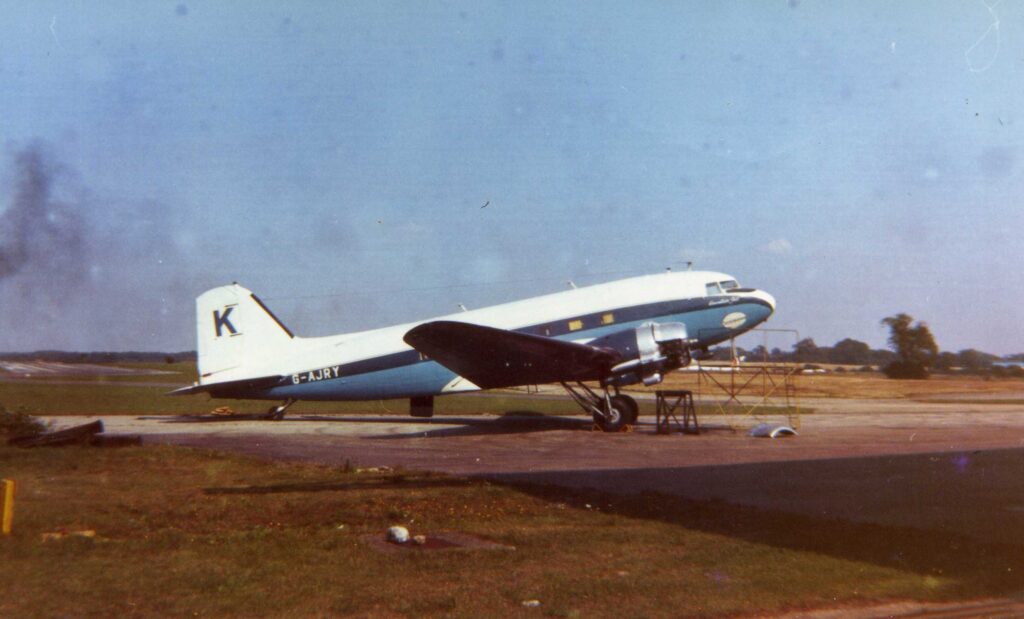
Early in 1971 G-AJRY flew to Basle with a Transmeridian crew to ‘recover’ DC-7CF G-ATMF which had been delivered to Hank Warton’s airline Arco (Bermuda) in February 1970. Intended as a spares queen, G-ATMF had remained intact and (possibly) not fully paid-for. Having transported the crew to Switzerland on January 15th, the Dakota returned to Stansted. G-AJRY was seen at Biggin Hill on June 11th 1971 with Keegan’s trademark ‘K’ on the rudder. In fact, the ownership of the aircraft was only formally changed from Transmeridian Air Cargo to T.D Keegan on September 16th 1971. The colour scheme hadn’t changed much since STC’s later days; the early STC white over grey with a pale blue cheat line had evolved to the more adventurous dark blue and turquoise scheme during a major overhaul in 1968. The colours were reminiscent of the Autair International scheme but also fitted well with Transmeridian’s chosen colours (14). In addition to the ‘K’, a Transmeridian globe was inscribed on the nose and the title ‘Executive Jet’ emblazoned beneath the cockpit. The rather incongruous title had inspired some wag to add ‘Beware of Jet Blast!’ next to the Twin Wasp exhaust stacks! The aircraft’s private status meant that a limited amount of work could be done for TMAC and flying hours remained low. She was generally to be found parked over the ‘far’ side of the airport between Aviation Traders and the Board of trade Fire School: in 1971 I logged her at dispersal on 14th April, 18th August, 27th August (when she was conducting engine run-ups) and 26th October. During this last visit, she presented a wonderful sight parked alongside Kemps Aerial Surveys vintage Anson G-AGWE. After preliminary checks, the Dakota embarked four or five passengers and departed around 10:30 am.
(14) Transmeridian’s associated company, Trans World Leasing, worked with a red/ white/ black/ silver palette and TMAC’s CL-44Ds were also silver/ red and black (including the globe insignia). This has always left me wondering whether G-AJRY’s two-tone blue colour scheme inspired the TMAC corporate letterheads of the 1970s or whether it was just a happy coincidence.
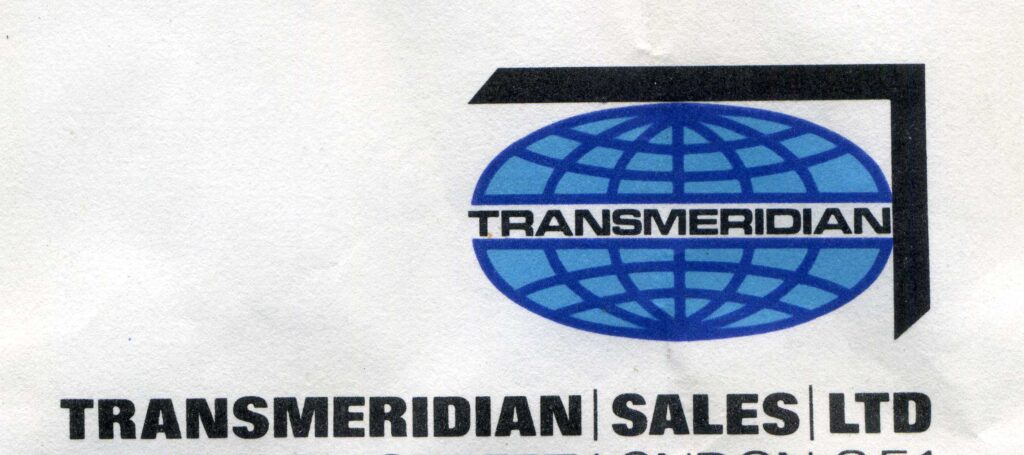
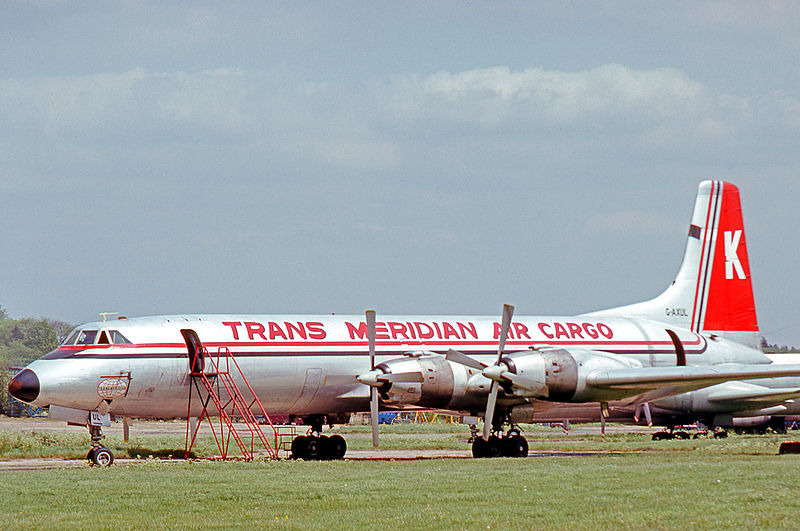
During late 1971, Mike Keegan was considering expanding his DC-3 ownership by purchasing the troubled Skyways Coach-Air. Eventually, Dan Air stepped-in to acquire Skyways passenger operations and Keegan moved-on to bid for Channel Airways in January 1972. Although this was also an unsuccessful offer, his acquisitive streak did bear fruit with the December 1971 purchase of British Air Ferries. Keegan’s plan was to combine CL-44D and Carvair operations on BAF flights to Europe from Southend and on long-haul freight flights to the Far East and Africa from Stansted.
G-AJRY, however, had been offered for sale for £15,000 as from November 1971. She was parked at Stansted on January 6th 1972, looking smart in the winter weather. Following the completion of a Check 2, the price briefly rose to £16,000 but G-AJRY’s career as an executive transport precluded the issue of a full Public Transport C of A without some expensive upgrading. In particular, fire prevention and detection equipment would need to be installed. G-AJRY therefore offered some appeal to air survey companies, freight operators or, thanks to the prestigious Remmert-Werner plate on the forward bulkhead, another executive operation. In late February 1972 the Dakota was despatched to Field’s for a Check 3 and was noted in action at Stansted on March 30th, landing and disembarking passengers over at the airport side (15). She appeared at the Southend Air Show in June 1972, but the show-casing still failed to yield a buyer and, during 1972, the asking price was reduced to £12,500.
TMAC were frequent operators of flights to the Sudan, Uganda and ethiopia and had ambitions to expand as far south as Zimbabwe (S.Rhodesia as it was then) and Zambia. Their first CL-44D, N448T/ G-AWWB, had been named ‘African Trader’ upon its arrival at Stansted on the last day of 1969 and the ambitious company intended to maximise the potential. G-AJRY departed for another sales trip to Africa at the end of 1972, passing through Malta on December 2nd/ 3rd en route to all points south. The expedition followed much the same route as the earlier mission and included Abidjan, Cote d’Ivoire, on the west coast. The Dakota was back in the UK just before Christmas 1972,passing through Malta on December 23rd.
On January 4th 1973, when I was fortunate enough to be able to visit the aircraft, G-AJRY was back at Stansted, snugly parked in the Transmeridian hangar in the company of the Keegan family Chipmunk G-ALWB. Internally, the passenger compartment was smartly-equipped with dark brown carpeting, pale brown seats and lower fuselage sides and pale blue roofing. the cockpit featured dark blue pilot’s seats and (for 1973!) an impressive array of upgraded instrumentation. By February 10th, G-AJRY had moved outside the hangar and was in the company of the aging DC-4 G-AZSI and the pale-blue striped ex-Spantax DC-4 G-BANO.
A further sales trip to Africa followed in March 1973 although, this time, the trip didn’t go 100% smoothly. Problems in West Africa left her ‘AOG’ at Lagos at the end of the third week in March and parts were despatched from Stansted to effect repairs. I noted that she was back at Stansted on March 25th, possibly that day. An engine was being unloaded over at the TMAC facility – but not a radial engine. Five days later, ‘RY had taken G-BANO’s place in the TMAC hangar and was receiving mechanical attention. The next time I saw her at Stansted, April 27th 1973, she had resumed her place next to the DC-4/ C-54 G-AZSI and the ill-fated CL-44D G-ATZH.
A sale was finally concluded the following year, 1974, with G-AJRY destined for export to South Africa. The Dakota’s function as crew ferry and sales mission transport was taken-over by the ex-Macedonian Dove G-ANVU. The preparation work for the flight south was carried-out by Aviation Traders at Southend as from 20th February 1974 and ‘RY departed for Madrid on 3rd March en route to Sand River Safaris of Johannesburg for operation by their associated company, United Air Services.
(15) I observed this arrival at Stansted on March 30th while I was reading copies of ‘RY’s past log books in the Transmeridian offices. TMAC were always extremely generous with their time and help.
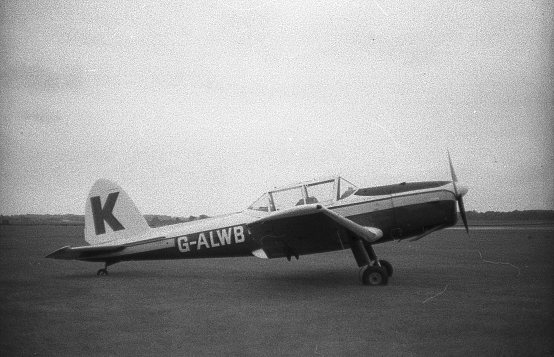
Highveld Life
If the personalised registration G-ASTC had been beyond the reach of Standard Telephones & Cables, the new owners had no such difficulties in South Africa. The directors of Sand River Safaris included Messrs Pieterse, Theron, Bower and they had a preference for registering their aircraft with initials P,T followed by ABC etc. The new addition became ZS-PTG on April 1st 1974. In September of the following year, Sand River acquired United Air Taxis, an air taxi company which had been formed in 1965 to link Johannesburg, Pretoria, Pietersburg and Sishen. The combined fleet comprised a Piper Navajo, two Piper Aztecs, ZS-PTG and a second DC-3, ZS-UAS, which had also incorporated company initials into its registration. ZS-PTG’s colour scheme had changed from STC’s two-tone blue to a new white over polished metal scheme with a red/ white/ blue cheat line and United titles.
Delaney:
ZS-PTG achieved new fame on October 15th 1975 when a baby girl was born during a scheduled flight between the mining town of Sishen and Johannesburg. The new aviatrix was named ‘Delaney’ – she could easily have become ‘Dakota’ but, in reverse, it was ZS-PTG which was named ‘Delaney’, a name she has carried ever since. ‘PTG’s pilot on that day, Captain Terry Chiole, was a veteran DC-3 pilot who had flown with Malayan Airways from Singapore in the 1960s. Ironically, he might very well have flown the ‘original’ G-AJRY/ 9M-ALO/ 9V-BAN during her residence in Singapore/ Malaysia/ Borneo. Captain Chiole’s role on United DC-3s was often combined with a Second Pilot/ Engineer and a Stewardess. He was a consummate pilot who frequently preferred to fly an aircraft manually rather than engage the autopilot. During 1977, his flying skills contributed to the logistics and visuals during filming of the movie ‘The Wild Geese’ at Tshipse using United’s ZS-UAS. He went on to fly with Caprivi Airways in 1978. It seems unlikely that his airborne skills ran to midwife duties but the delivery on ZS-PTG was successful and Terry Chiole was able to meet the 23-year old Delaney in the company of the aircraft bearing her name on 24th October 1998 (a reunion in December 1988 at Lanseria Airport may also have taken place).
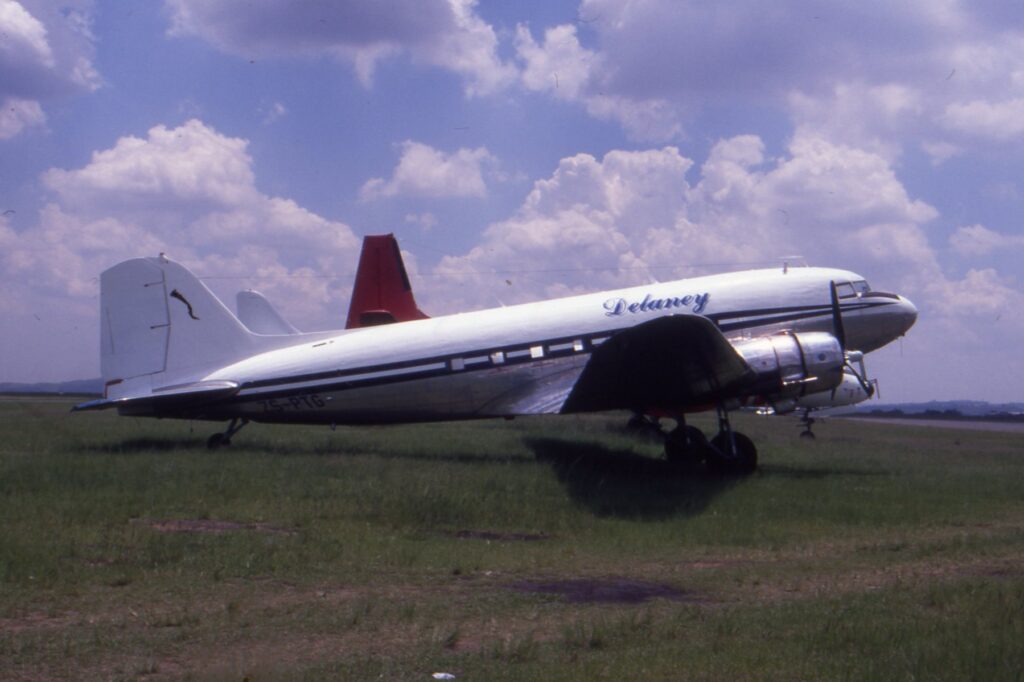
A third DC-3, ZS-GPL previously of Grindrod’s amusing Grinair, joined Sand River in March 1976 to assist with the Company’s varied operations.
The political geography of Southern Africa was changing during the late seventies and the Lancaster House agreement of December 1979 stopped Rhodesia’s Bush War and paved the way for elections in February 1980 and the subsequent formation of the state of Zimbabwe. Logistics for the elections incorporated the movement of many former bush fighters to their family homes and the establishment of a network of invigilators. Air support was required and all United Air Services DC-3s were chartered for the short duration of the project. Owing to South Africa’s political isolation at the time, the Dakotas were re-registered to one of Sand River Safaris’ subsidiary companies, Air Services Botswana as A2-ACF (ZS-UAS), A2-ACG (ZS-PTG) and A2-ACH (ZS-GPL) between February 8th and March 1980.
Business remained brisk for United with a Viscount being added to the fleet in 1979 (16) and some scheduled services shared with Magnum Airlines, a fellow Johannesburg third-level operator formed in 1978. The good fortune, however, didn’t last and, by January 1986, ZS-PTG was parked without engines at Rand Airport. The Viscount was sold to MMM Aero Services of Zaire in July 1986 while the remaining DC-3, ZS-UAS, continued to fly. The United operation came to a tragic end on April 12th 1988 when ZS-UAS crashed in a ball of flames in a maize field at Hennenman, Orange Free State. The DC-3 had been mobilised to Bloemfontein to pick-up a group of jockeys and trainers stranded after the day’s race meeting owing to the non-operation of a scheduled SAA flight. Following take-off, fire broke-out in the starboard engine and spread rapidly to the fuselage aft of the cockpit. The pilot attempted to return to Johannesburg but was unable to maintain height. The ensuing crash killed all 24 occupants including 13 young jockeys – it is remembered to this day, over 40 years later, with a memorial horse race. The subsequent investigation suggested that the crash was due to a faulty starboard fuel booster pump. Inadequate maintenance was cited with suggestions that airworthiness certification may also have been falsified. Some reports claimed ‘thousands of hours without maintenance’ which seems hugely exaggerated, but it seems strange that culpability was laid at no-one’s door. The crash of ZS-UAS ‘Wild Geese’ and the subsequent enquiry spelled the end for United Air Services and the airline went into receivership.
(16) Viscount ZS-JVY was initially owned by Aviation Hire & Travel Pty who brought the aircraft to Africa from Burma in 1976. In the often convoluted manner of aircraft operation in southern Africa, it was leased at various times to Royal Swazi Air and sub-leased to Air Botswana during the late seventies/ early eighties. It may also have been leased by United as it appeared in the pea green scheme used in Botswana coupled with United titles before emerging in full United colours. The Swazi red/ white/ blue scheme used seems exactly the same as United’s scheme and the connection may be that Air Services Botswana Pty, a Sand River Safari associate, operated the services of Air Botswana (Pty) between 1973 and 1982 and was also connected to Swazi Air. Either way, the Viscount was only sold to United in 1983.
Delaney Moves On:
The remnants of United were bought by Wonder Air and ZS-PTG was registered by them on December 19th 1988 in the name of their subsidiary Avia Air Charter. ZS-PTG was overhauled and painted in a clean grey/ black/ white scheme: ‘Delaney’ and her sister DC-3 ZS-GPL flew from the airfield at Wonderboom during the late 1980’s and early nineties before moving to Freeway airfield north of Pretoria in 1992. They remained based there until Avia halted operations in 1995. It was during this period that Wonder Air/ Avia’s proprietor Gert de Klerk began building turboprop-engined DC-3 conversions for the South African Air Force (17). Having avoided being cannibalised during United’s dog days of 1986, ZS-PTG’s streak of luck continued and she wasn’t added to Wonder Air’s Turbo Dak programme.
(17) Anti-apartheid sanctions prevented the SAAF from replacing their aging Shackleton marine reconnaissance fleet. A substantial number of Dakotas remained in service with the SAAF and an upgrading programme seemed feasible. BEA had experimented with turbo DC-3s in the 1950s, Conroy Aircraft of California in the late 1960s, but neither had been entirely successful. The AMI Company of Fort Worth, Texas, made a new attempt in 1987 with its TP Cargomaster and, with further design input from Schafer Aircraft Modifications of Waco, this seemed more viable. These companies partnered with Wonder Air to produce DC-3s suitable for marine reconnaissance: the fuselage was stretched by just over a metre and new Pratt & Whitney Canada turboprops with 5-blade reversible Hartzell propellers installed. ‘Project Felstone’ envisaged the conversion of up to forty Dakotas and the first airframes were selected in 1989. In addition to Dakotas inherited from the RAF and those transferred from SAA, various others had been added to the SAAF roll call either openly or by subterfuge.
ZS-PTG was sold to Debon-Air on December 23rd 1995 and was refurbished internally and externally with a new colour scheme which retained her name ‘Delaney’ prominently featured on the fuselage. She was accompanied at Debon-Air by DC-3s ZS-OJE, ‘Delamere’, and ZS-OJD, ‘Victoria’, and was a frequent visitor to Wonderboom and Grand Central (Mid Rand) airports during the late 1990s from her base at Lanseria. She briefly swapped her ‘ZS’ indicator for a Belgian ‘OO’ when appearing in a movie as OO-PTG. Sometime in 2000/ 2001, all three aircraft appear to have acquired a pale blue and white colour scheme with a light blue fin and titles. ZS-OJE and ZS-OJD were sold to the Democratic Republic of Congo in late 2001 and departed for Lubumbashi (18). ZS-PTG’s run of luck continued and was sold to Rohan Vos on June 14th 2002 for use by his nostalgia rail/ air operation Rovos Rail. A further extensive overhaul produced another new paint scheme with smart dark green coach lines and an internal refit with 21 dark green ‘business class’ seats. Following a lifetime’s habit of adopting (or trying to adopt) owners initials into her registration, Delaney was re-registered ZS-CRV. For the next six years she would lead a relatively pampered life based at Johannesburg’s Lanseria airfield where hangar facilities were available.
(18) ZS-OJD, c/n 4890, was one of the ex-Spanish Air Force C-47 fleet purchased in 1978 by Doug Arnold (see notes in Relics- Salamanca thread). Briefly registered G-BFXA, she moved to the Kanana Sugar Corporation of Khartoum as ST-AHK in November 1978. It was a brief stay and the Dakota moved to Sunbird Aviation of Nairobi where, during 1980, she was grounded and became a spares queen for the operator’s other C-47s. Sunbird was bought by Air Kenya in November 1987 and, in 1990, the Company decided to rebuild the Dakota. Registered 5Y-BGU on May 16th 1990, the C-47 took to the air again on March 9th 1991 and remained operational until sold to Nerocro and exported to South Africa. Debon-Air acquired her in May 1999 and christened her ‘Victoria’ after Chief Executive Denise Bottger’s daughter. Information from article by Steve Kinder, Propliner # 84, Autumn 2000.
Rovos Rail had been formed in 1989 and continues to operate today. The air division was started in December 2001 with the arrival of two ex-Bolivian Convair 340s and expanded with the addition of Delaney. Various flights were operated, the most popular being from Pretoria to Victoria Falls. She did, however, cover a wider area and, on March 9th 2005, was seen in Luderitz, Namibia. A You Tube clip for 15th February 2004 recorded by Jan Koppen shows ‘CRV on a Sunday morning ‘Champagne flight’ around Johannesburg. The Remmert Werner conversion plate on the bulkhead is clearly visible in the video. The Rovos air division proved less successful than the rail operation and was closed on September 30th 2008. The Aviation division is recorded as being sold to TIM Holdings (Pty) in 2009 and they later operated briefly as Gryphon Airlines. The historic aircraft, however, seem to have remained on Rovos’ books for several more years while new owners were sought. During this period, Delaney was initially leased to Namibian Commercial Aviation (NCA) in Windhoek while the two Convairs lingered on in South Africa while advertised for sale (19).
(19) Convair ZS-ARV was advertised at $450k in October 2008 but, with no takers, this had dropped to $250k by June 2013. She was eventually sold to a preservation group in Australia and successfully flown there in 2016. Convair ZS-BRV remained in South Africa until donated to the Aviodrome Aviation Museum of Lelystad in the Netherlands. Repainted in Martins Air Charter colours, the aircraft was tragically written-off in a fatal crash after take-off from Wonderboom, Pretoria, on the day before its scheduled departure for Europe.
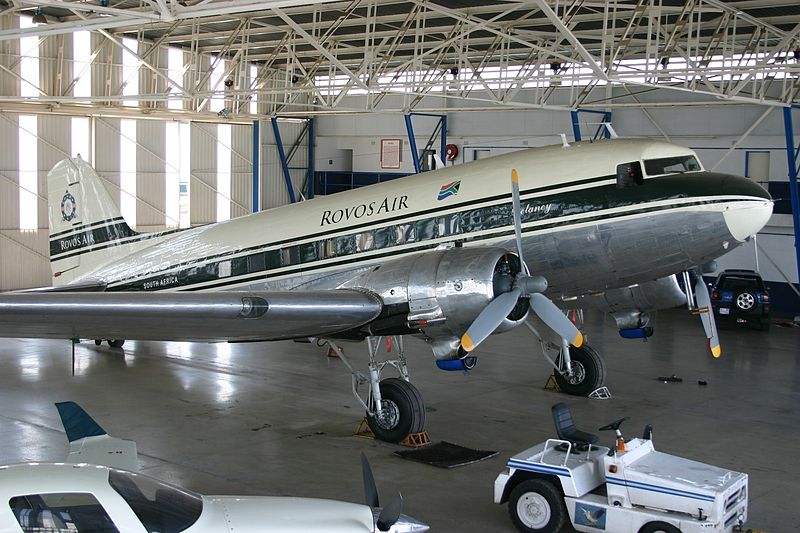
NCA was owned by the ex-SAA Station Engineer at Windhoek, Chris Schutte. Initially a flying tuition and light aviation centre called Hire & Fly, the company became NCA in 1989 and, by 1992, operated around fifteen twin-engine Cessnas. After obtaining a UN contract for operations in Angola, Schutte bought DC-6A V5-NCB and added a second in September 1991. While negotiating to buy 40 tons of DC-6 spares from the Zambian Air Force, he was encouraged to purchase two DC-6Bs which had been parked in Zambia for 15 years (20). Registered V5-NCF and V5-NCG, the former was operational by March 1995 and was subsequently sold to Red Bull, departing Windhoek on 7th July 2000 for the 28-hour flight to Salzburg. The second DC-6B made its first revenue-earning flight on March 31st 2001 and was used on sight-seeing safari flights from Windhoek’s Eros Airport to destinations around Namibia, to the Victoria Falls and the Kariba Gorge. The lease of Delaney supplemented the Company’s operations for a while prior to Chris Schutte’s untimely death on 5th November 2010.
ZS-CRV appeared wearing various other titles during the next few years but it seems likely that she remained owned by Rovos until sold to Menno Parsons towards the end of 2015. In the interim, she was noted flying from Lanseria and Wonderboom Airports, often wearing the titles of well-known DC-3 pilot Flippie Vermuelen’s company Classic Air Travel. In September 2009 she was at Makokula Airport, Malawi being piloted by Flippie Vermuelen. She starred in the 2011 Wonderboom Air Show and a U-tube clip shows her departing Luderitz, Namibia, on October 24th 2013 still appearing to wear Rovos Air titles. The following year ZS-CRV appeared at the Botswana Air Show at Wesbank wearing Classic Air Travel and Rovos titles. Classic Air had a history of operating Dakotas in South Africa with ZS-NTE, ZS-KEX and ZS-GPL all being operated by the family company comprising Flippie, his daughter Petro and son Ben (21)
(20) President Tito of Jugoslavia donated the two DC-6Bs to President Kaunda of Zambia in 1975. One had been Tito’s personal aircraft (V5-NCF) while the other (V5-NCG) was ex-JAT and the last DC-6B built.
(21) Of Classic’s Dakotas, ZS-NTE was sold to German businessman Peter Adrian and delivered to Zweibrucken via Cascais in Portugal by two Cargolux pilots. She became well-known for her ‘Aer Lingus’ colour scheme and currently (2022) operates for ‘Steel Buddies’ entrepreneur Michael Manousakis on ‘Olive Air’ flights from Germany to Crete. Classic followed this with ex-Dept of Transport DC-3 ZS-CAI bought in 2015 and operated until sold to Martin Back of New Jersey. ‘CAI was delivered to the USA in October 2018 via Luanda, Las Palmas, Laejes (Azores) and Bangor, Maine. ZS-GPL became 5H-DAK with Indigo Aviation in Tanzania.
Rovos’s house newspaper, the ‘Rovos Tribune’ noted the sale of ZS-CRV, Delaney, in the November 2015 edition with technology entrepreneur Menno Parsons the new owner. A keen pilot himself, Menno Parsons is the proprietor of Masterpower Technologies and owns a number of interesting aircraft including a Mustang P-51. ZS-CRV is also frequently flown at air displays by well-known DC-3 pilot Derek Hopkins and he was at the controls for the 2016 Botswana International Air Show on 28th May at Matsieng, north of Gabarone. At Newcastle Air Show, June 2nd 2018, Derek Hopkins was again piloting ‘Delaney’ for formation flying alongside the ‘Team Xtreme’ aerobatic aircraft flown by his son. 2018 also saw ZS-CRV flying Children’s Flight air experience missions on August 31st and September 1st from Grand Central as well as, at the other end of the age spectrum, an Elders Flight on 30th November 2018. The Elders event involved multiple flights from Rand Airport carrying a total of 120 older South Africans.
In 2024, ZS-CRV celebrated her 80th birthday, still under the careful ownership of Menno Parsons. Today, she flies from the Krugersdorp/ Mogale City airstrip to the west of Johannesburg.
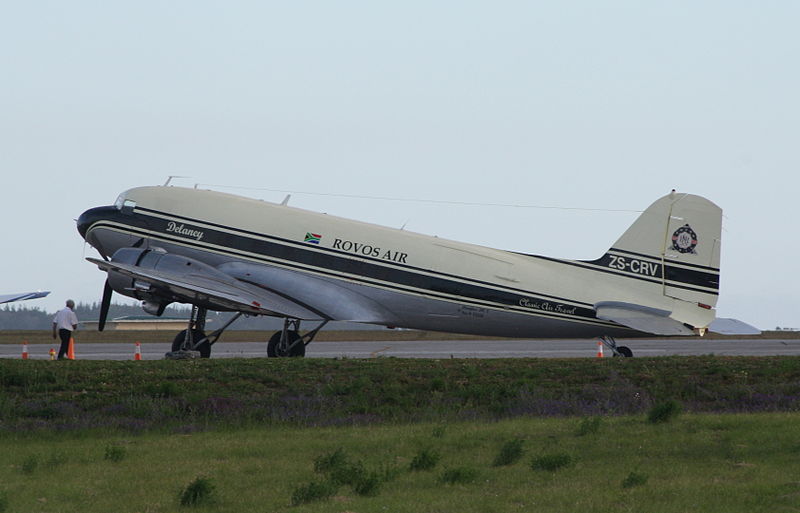
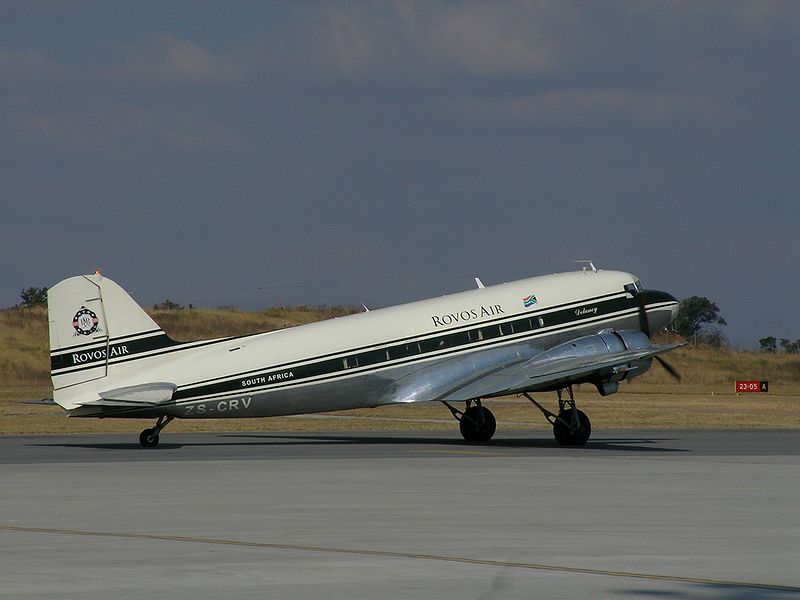
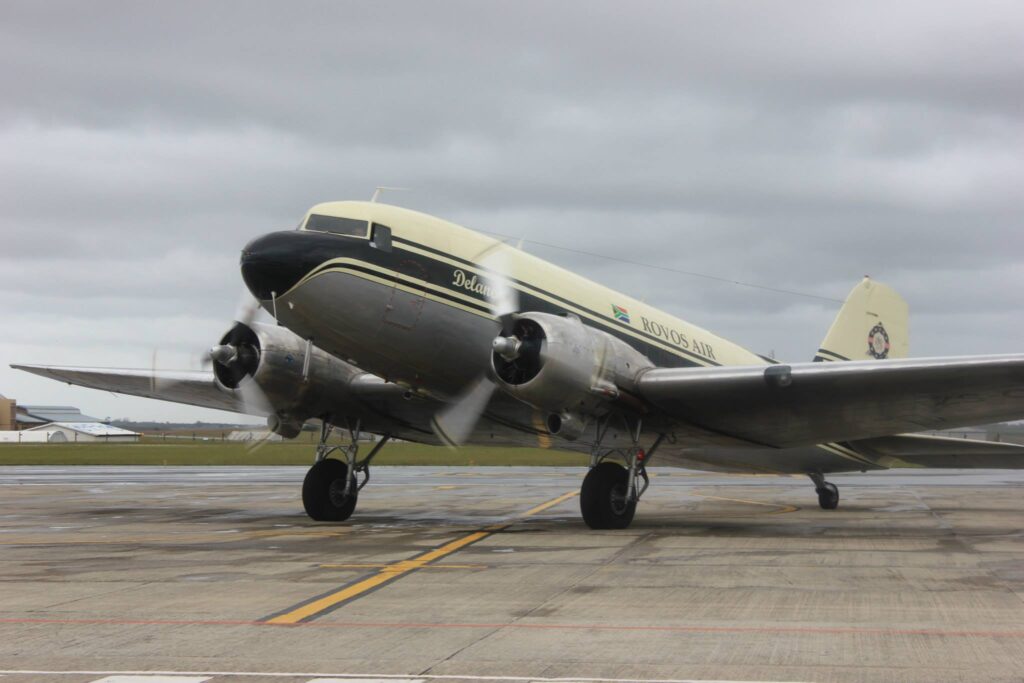
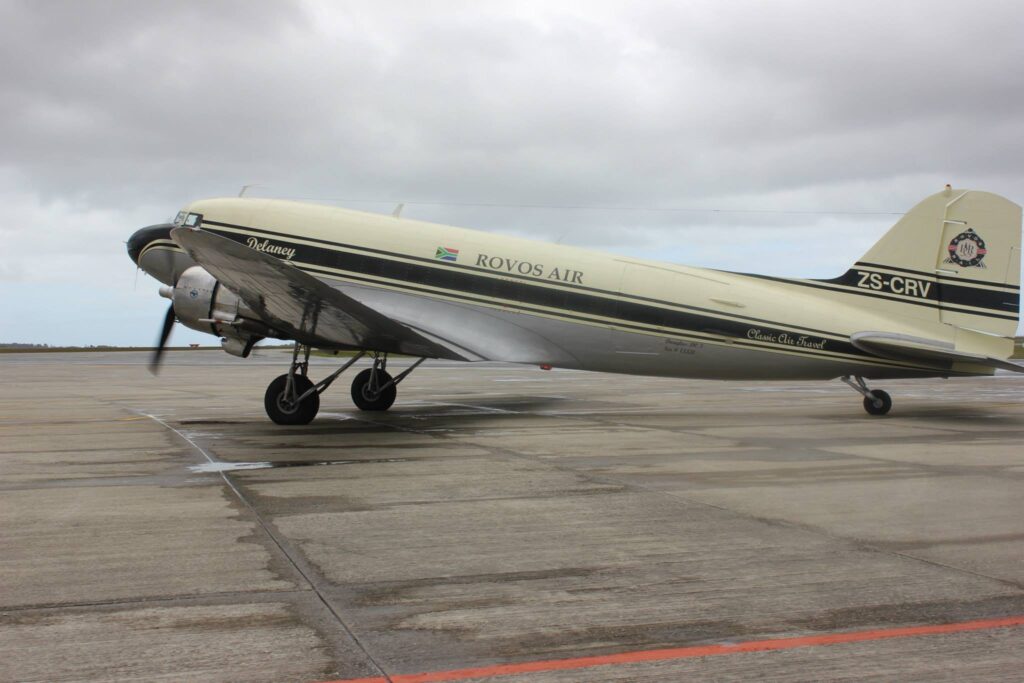
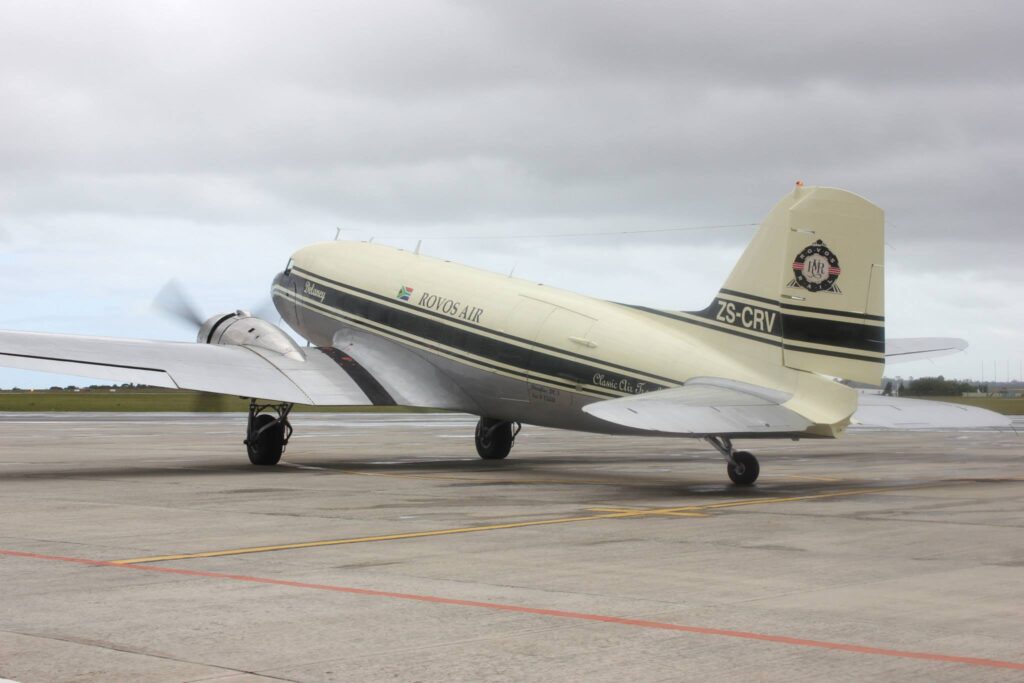
Hits: 596
